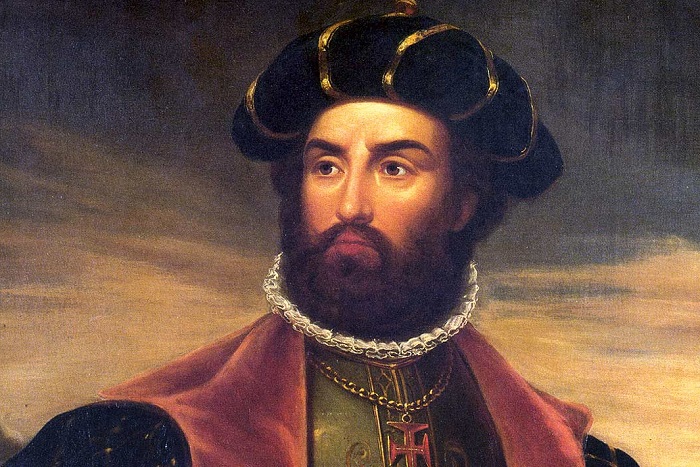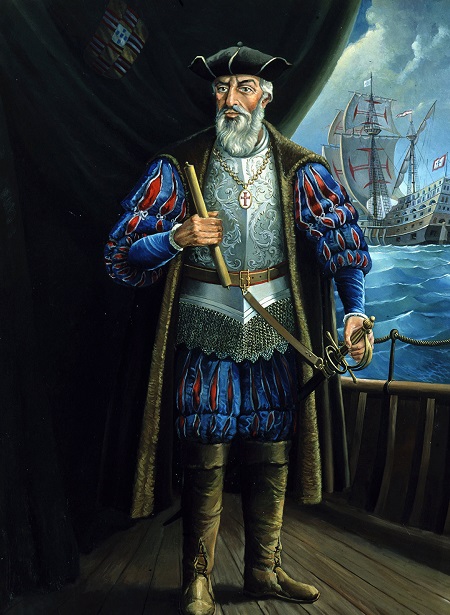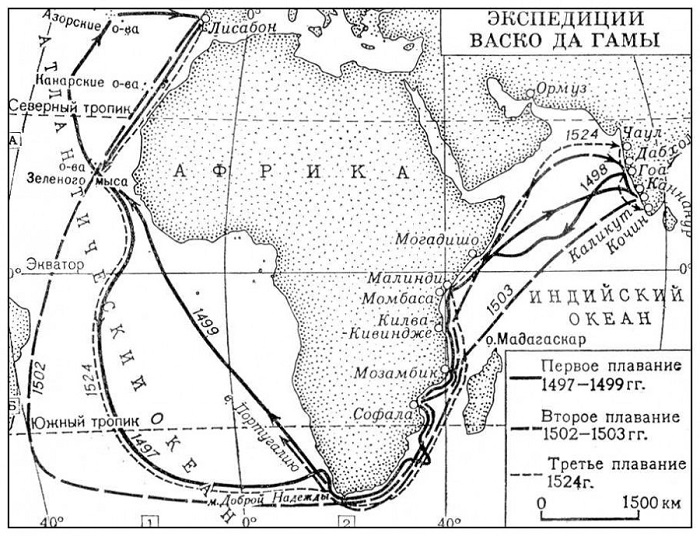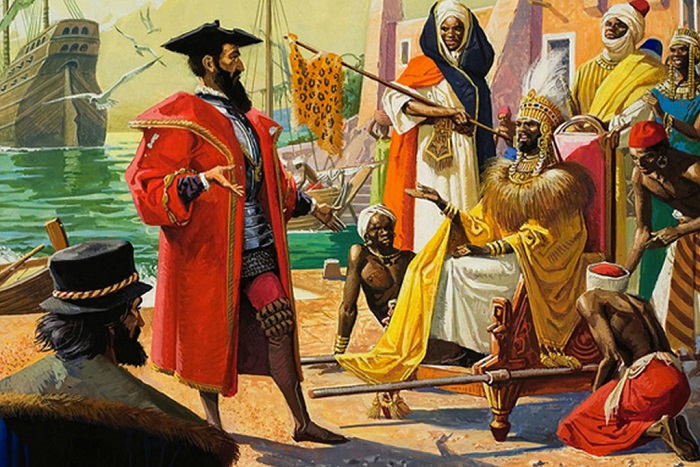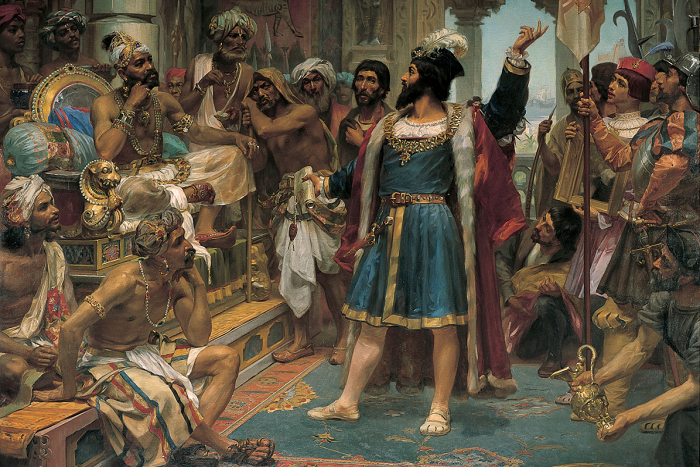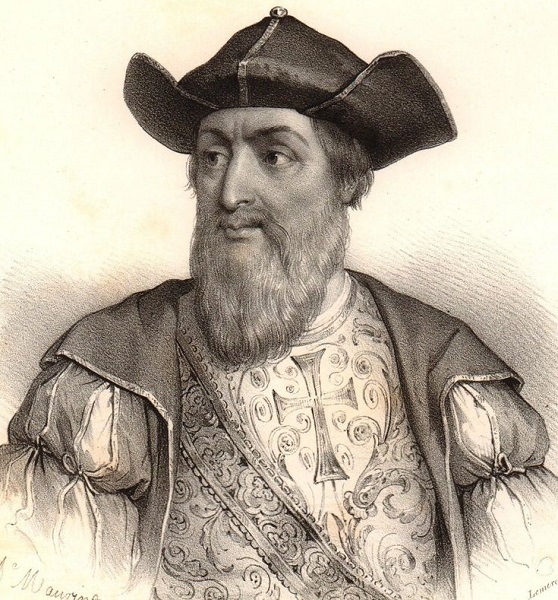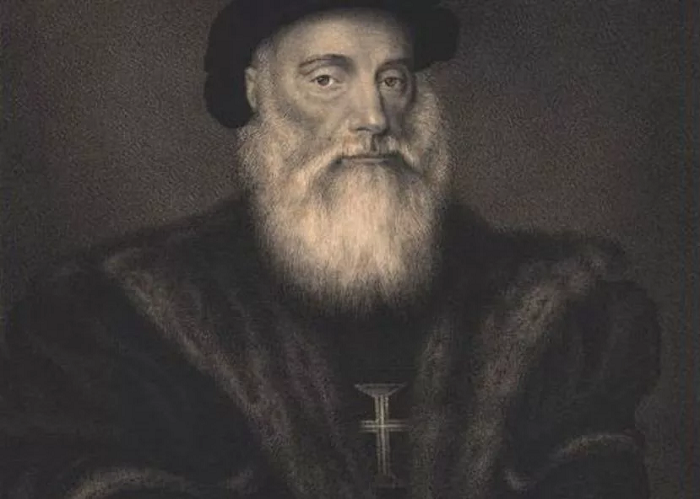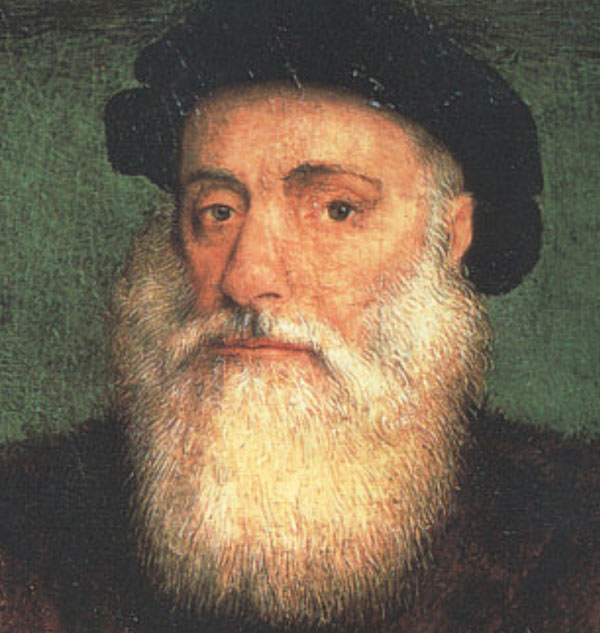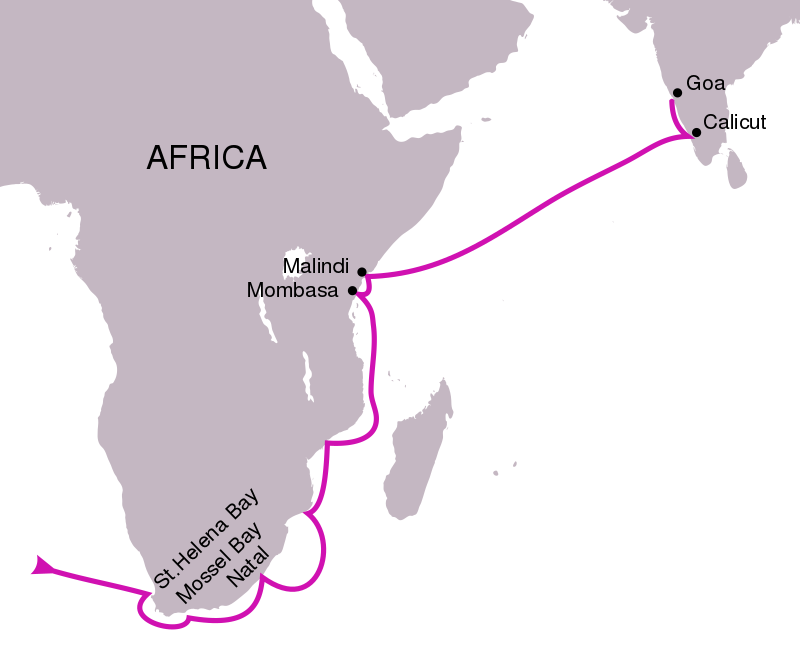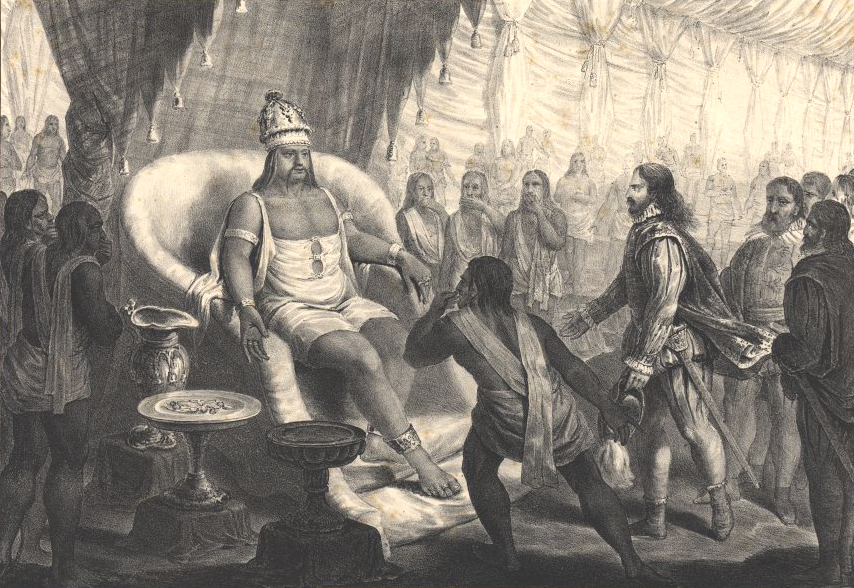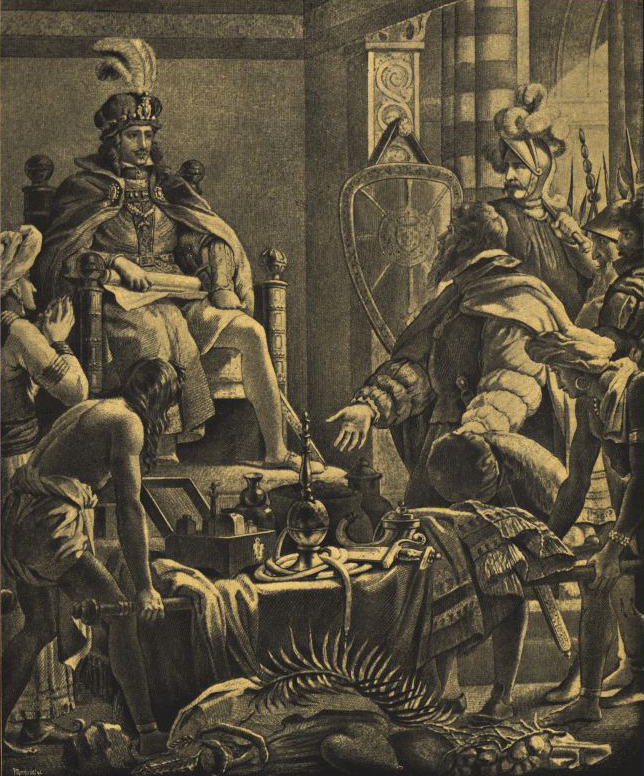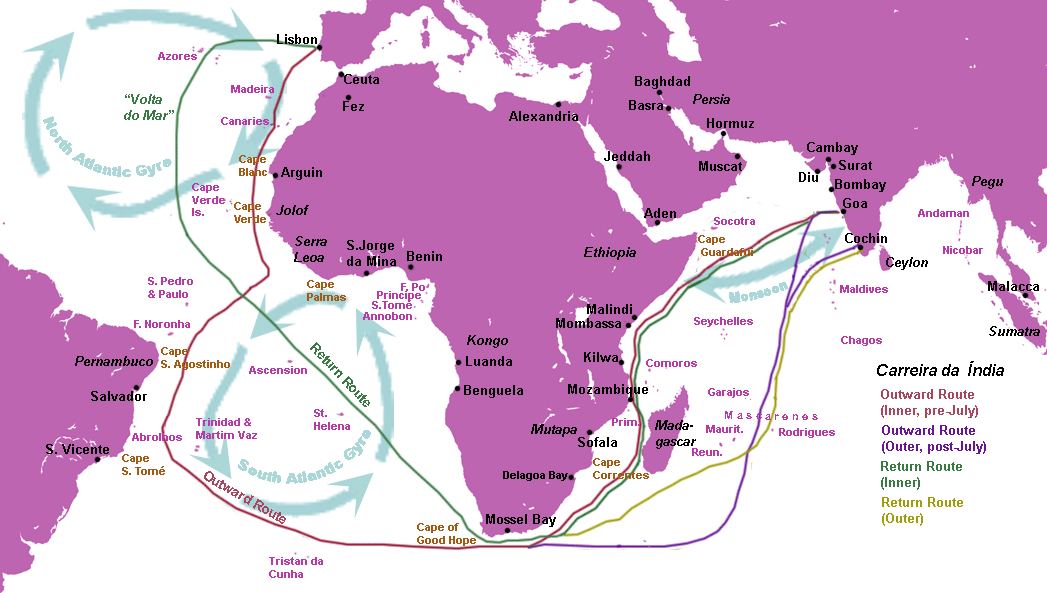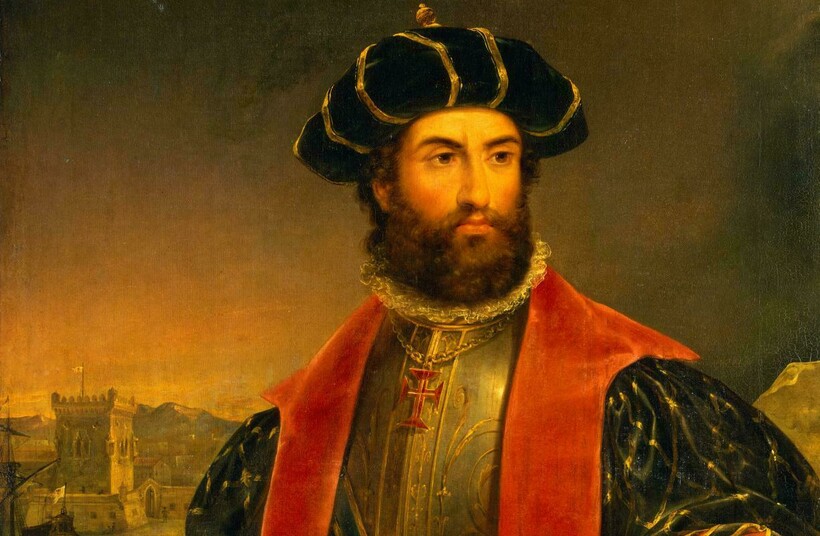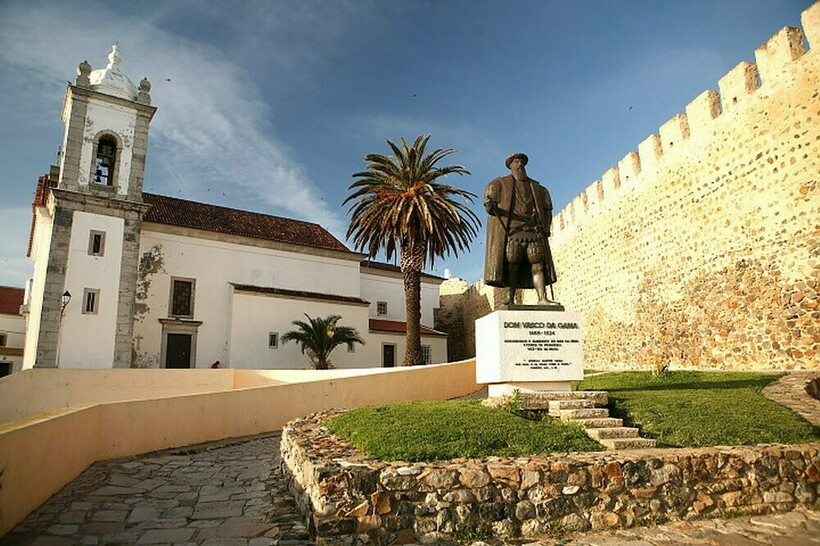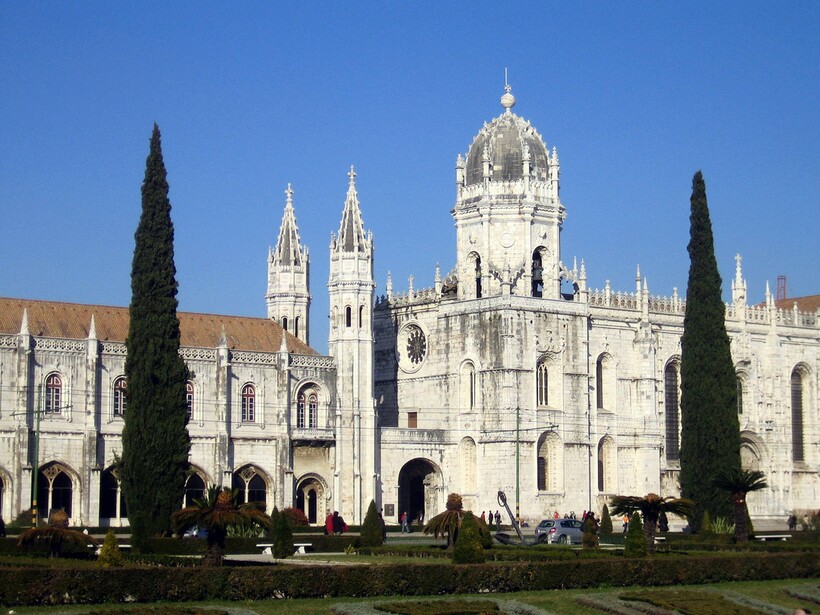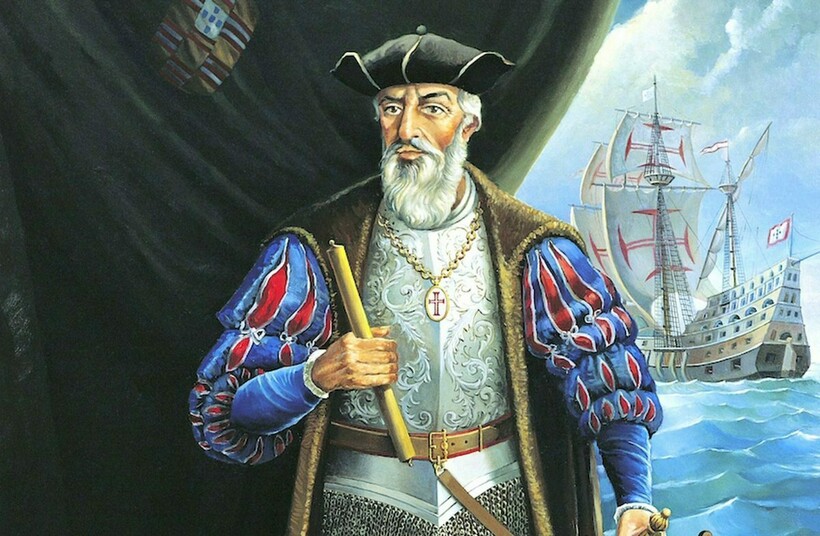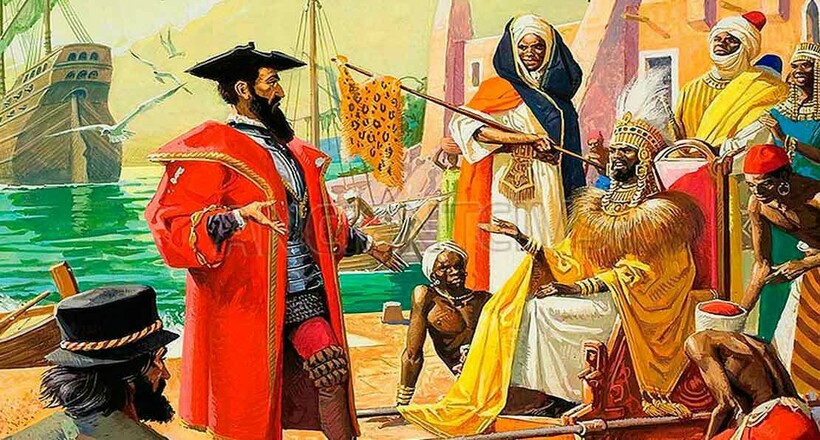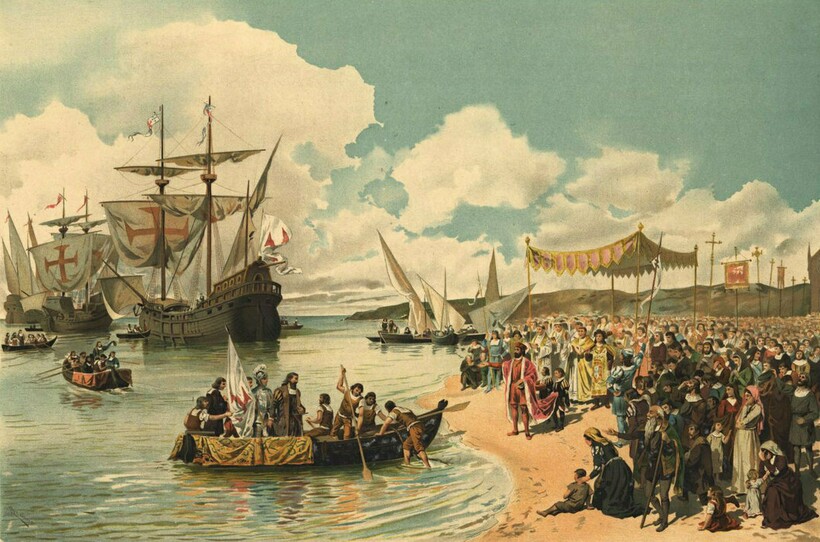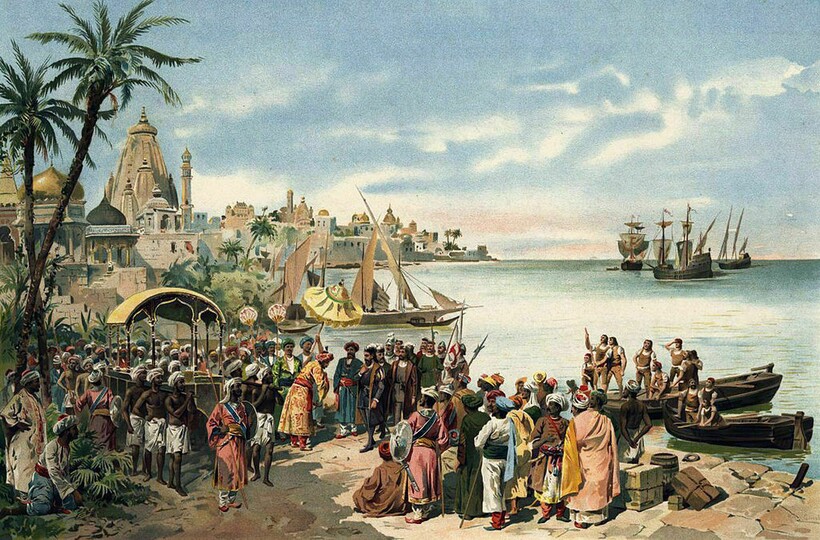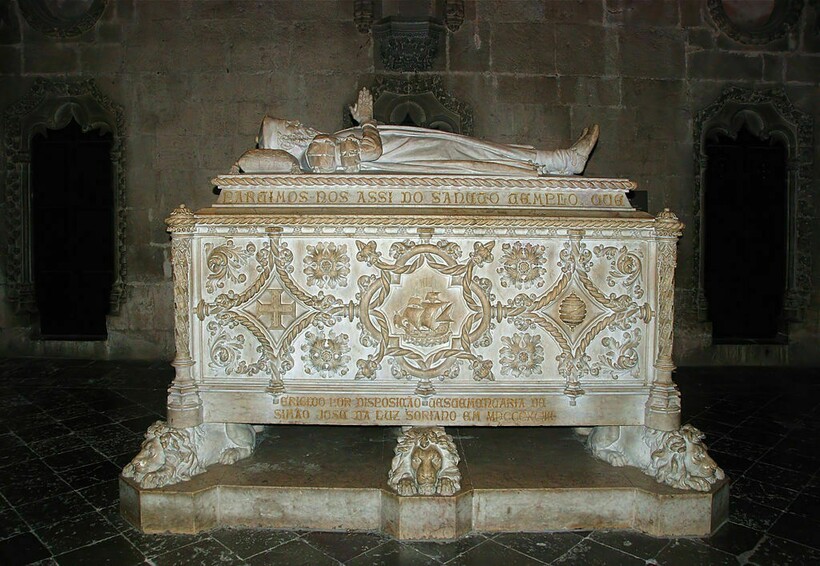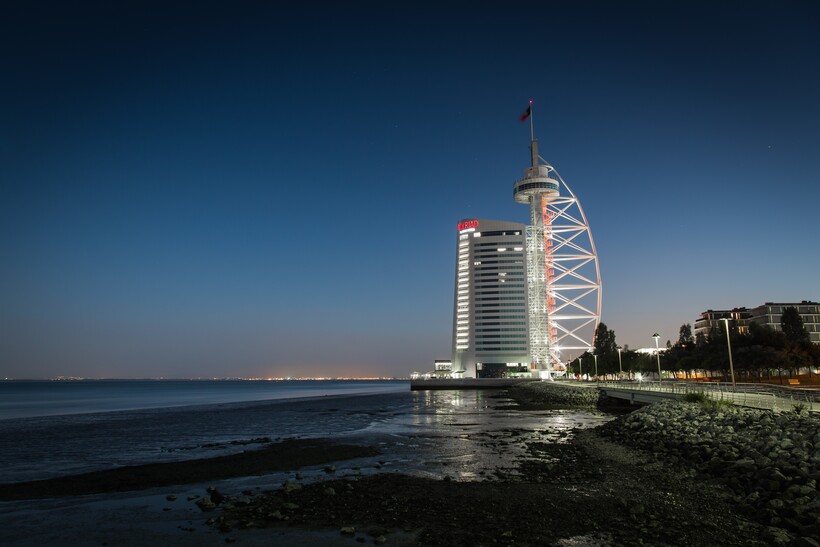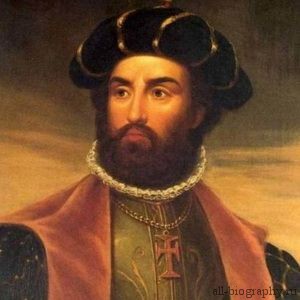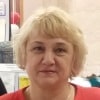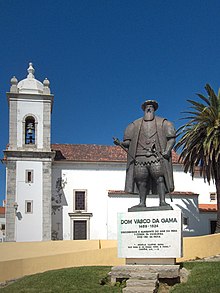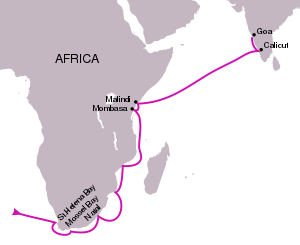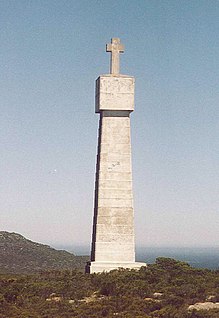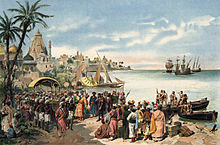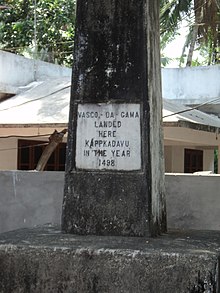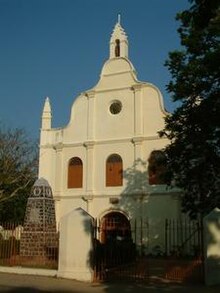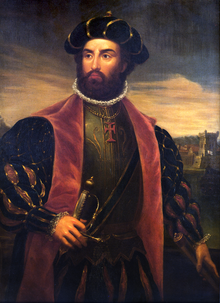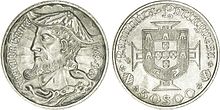Содержание
- Эпоха великих географических открытий
- Кто такой Васко да Гама? Немного из биографии
- Путешествие в Индию
- Первое плавание
- Второе плавание
- Третье плавание и смерть
- Подведение итогов
Васко да Гама — португальский мореплаватель, чьи путешествия в Индию (1497–99, 1502–03) , 1524) помогли открыть морской путь из Западной Европы на Восток через мыс Доброй Надежды.
Эпоха великих географических открытий
С 15 по 17 век человечество развивалось в направлении географических открытий, которые были обусловлены поиском новых земель и морских маршрутов в Африку, Америку, Азию и Океанию. Таким образом европейцы находили новых торговых партнеров из разных точек мира. Многие стремились попасть в Индию, ввиду ее прославленности драгоценными металлами, камнями, пряностями и специями. Поэтому, пользуясь своим географическим положением, Португалия решила расширить свои торговые связи с помощью новых путей сообщения.
Кто такой Васко да Гама? Немного из биографии
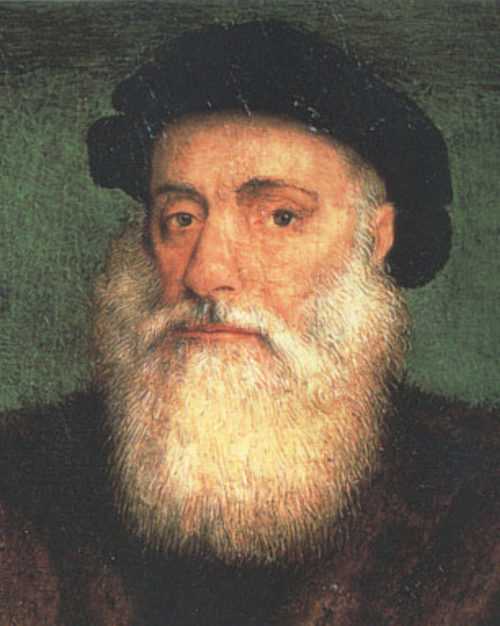
Васко да Гама— знаменитый португальский мореплаватель. Он возглавлял экспедицию в Индию, которая помогла наладить торговые отношения между двумя странами и открыть новые морские пути, что стало главным достижением в его жизни и очень полезным географическим открытием для всех.
Васко да Гама родился в 1460 году (по некоторым историческим данным в 1469 году) в семье португальского рыцаря Эштевана да Гама и его жены Изабель Содре. В семье да Гама было много детей: пятеро сыновей и дочь. Все дети получили неплохое образование, изучали некоторые науки, например: математику, навигацию и астрономию. Историки считают, что Гама получил образование в Эворе, а его учителем был сам Авраам Закуто. Перед своей первой поездкой в Индию Васко даже посоветовался с ним в нескольких вопросах и всегда держал на борту астрономические таблицы и астролябии.
С ранних лет Васко принимал участие в морских сражениях, внимание португальских властей он привлек своим отважным поведением, когда в 1492 году принял участие в вооруженном сражении с французскими пиратами за португальский корабль и без колебаний помог отвоевать его. А в 1480-х годах вступил в Орден Сантъяго вместе со своими братьями.
Путешествие в Индию
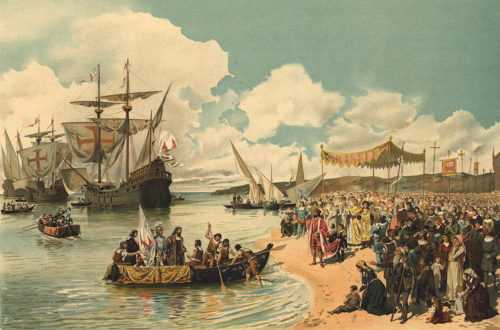
Первое плавание
После тщательной подготовки к экспедиции и отбору большинства членов своей команды команды, в 1497 году, Васко и его брат Паулу, который являлся вторым капитаном корабля, отправились в путь из Лиссабона до Канарских островов. Командующие приказали обойти острова стороной, чтобы избежать утечки информации среди испанцев о целях этой поездки.
Причалив к бухте, позже названной моряками Святой Еленой, моряки остановились для ремонта кораблей, но вступили в конфликт с местными жителями. Им пришлось принять участие в битве, которая стала “основоположницей”, но серьезных потерь для команды Васко не понесла.
В середине зимы команда уже достигла берегов ЮАР, после чего, пополнив запасы провизии, отправилась дальше по заданному пути.
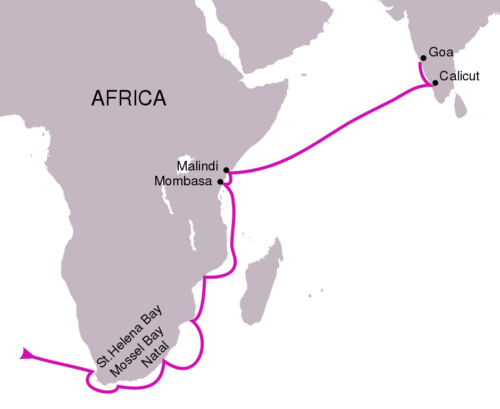
Проплыв мимо мыса Доброй Надежды, Васко со своим отрядом достигли территорий, которые долгие годы служили частью торговых путей в Индийском океане. По дороге к конечному пункту они заглянули в несколько прибрежных африканских поселений.
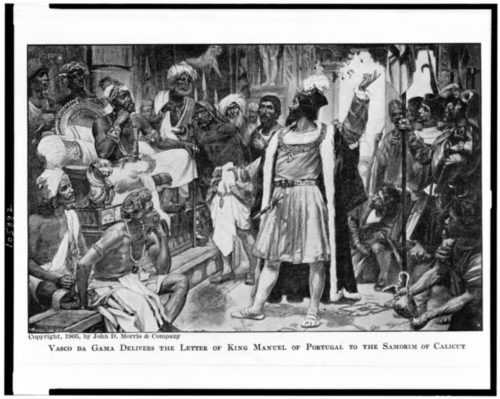
В 1498 году путешественники добрались до индийской земли, где местный царь пригласил на аудиенцию командующего в сопровождении 13 человек. По наставлению португальского короля, Васко даже передал некоторые подарки, но торговцам при дворе они не приглянулись. Целый год мореплаватель провел в Индии, пытаясь наладить торговые отношения двух стран, однако, не получив желаемого результата, покинул город вместе с двадцатью рыбаками, запасом пряностей и специй.
Второе плавание
Сразу после открытия морских путей в Индию, король Португалии ежегодно посылал туда корабли. В 1500 году состоялась экспедиция под руководством Кабрала Педру, которая потерпела неудачу. Поэтому, в 1502 году Васко да Гама во уже во второй раз отправляется в страну специй и драгоценностей. Король Португалии отправил эскадру во главе с выдающимся мореплавателем с целью наладить отношения между странами и колонизировать Индию. Одной из задач Васко да Гама являлось занять лидирующие позиции на рынке, избавившись от конкуренции с арабами.
Уже в феврале 1502 года некоторые судна покинули Португалию. На пути в Каннур команда выступила инициатором вооруженного сражения с арабскими кораблями. Всех пассажиров этих кораблей заперли в трюме, а само судно было сожжено. В октябре флот достиг Каннура. Португальцы были торжественно встречены местным раджой, после чего получили разрешение на постройку фактории. Запасенный пряностями, Гама со своими людьми двинулись на Каликуту, где им жестоко были убиты местные жители. Обстрел города происходил в течение нескольких дней, а затем, догрузив свои корабли, экипаж отправился назад в Лиссабон, где вновь получил похвалу и деньги от короля Португалии.
Третье плавание и смерть
По наставлению Васко король Мануэл I ввел должность вице-короля Индии. А король
Жуан III, в свою очередь, назначил на эту должность самого первооткрывателя Индии.
В это время и случилось его третье путешествие. В апреле 1524 года Васко прибыл в Индию в сопровождении двух своих сыновей. Там он твердо заявил о своем несогласии со злоупотреблением колониализмом. Ему не нравилась концепция нелегальной торговли и вражды между португальскими дворянами, которая каждый раз заканчивалась кровопролитием, поэтому он попытался искоренить обе эти проблемы.
Умер знаменитый мореплаватель в декабре 1524. Страшная болезнь малярия забрала его жизнь еще до отъезда в Португалию. Тело его было перевезено через 15 лет после кончины.
Подведение итогов
Васко да Гама был жестоким и властным человеком, но при этом отважным и целеустремленным. Включая все эти качества в своем характере, он смог выполнить все поставленные португальскими властями задачи, наладить сообщение с Индией, которое по тем временам Португалии было необходимо, и преодолеть все трудности, любой ценой достичь цели. У мореплавателя за спиной немало и других достижений и титулов, которые он получал в течение всей своей жизни. Отвага и вера в себя сопровождала его на всем жизненном пути.
Открытие Индии перевернуло европейское представление о мире. Такая ценная информация как пути сообщения в Индию, которая являлась “лакомым кусочком” для европейцев, досталась Португалии только благодаря настойчивости Васко и его команды. Экономическое положение в стране было подвержено разрушению, подчинение и колонизация Индии благотворно повлияла на эту проблему, решило ее. Таким образом, под руководством португальских королей, Васко да Гама помог защитить свою страну от бедности и стал непризнанным “героем”.

Гугломаг
Спрашивай! Не стесняйся!
Задать вопрос
Не все нашли? Используйте поиск по сайту
В XV веке обедневшая после Реконкисты Португалия искала возможности обогащения на восточных товарах без посредства венецианских или арабских торговцев.
По приказу короля сухопутные и морские пути исследовали отважные офицеры – Бартоломеу Диаш, Педру да Ковильян, Васко да Гама, краткая биография которых приоткрывает современному человеку окно в эпоху Великих географических открытий.
Краткая биография великого мореплавателя
Васко да Гама (Vasco da Gama, годы жизни 1460 — 1524) родился третьим в знатной семье коменданта крепости португальского порта Синиш. Дворянин получил хорошее образование.
Изучал такие науки, как астрономия, математика, география. Еще в юности будущий мореплаватель вступил в рыцарский орден святого Иакова и участвовал в многочисленных сражениях.
Талант молодого дворянина привлек внимание короля Мануэла I, и тот назначил его командующим морской экспедицией к берегам Индии. Экспедиция тщательно подготавливалась ещё с 1487 г., когда Бартоломеу Диаш впервые доказал, что африканский материк не соединен с полюсом, и проложил путь к мысу Доброй Надежды.
В июле 1497 г. Васко да Гама выступил в море на четырех превосходно вооруженных кораблях, 21 ноября обогнул оконечность Африки, вышел в Индийский океан, а к маю 1498 г. достиг Калькутты.
Спустя более чем два года плавания, первооткрыватель вернулся в Португалию, потеряв половину кораблей и большую часть команды, но привезя взамен диковинные восточные товары. Доклад о путешествии положил начало масштабной европейской экспансии.
По возвращении Васко да Гама получил титул дона и звание адмирала. В 1502 г. офицер уже на 20 кораблях совершил второе плавание в Индию с целью подчинить местное население португальской короне, а также отомстить туземцам за разрушение фактории и убийство христианских моряков.
В третье путешествие, в 1524 году, в страну специй мореплаватель отправился уже будучи вице-королем Индии, однако вскоре заболел малярией и на родину уже не вернулся. Дата смерти исследователя — 24 декабря 1524 г.
Что открыл Васко да Гама
Во время первого плавания в Индию португальский дворянин совершил важнейшие открытия, ставшие ключом для дальнейшей колонизации Востока.
Прежде вся территория на северо-восток от мыса Доброй Надежды, за исключением небольшой гавани Пастухов, которую описал Б. Диаш, была для европейцев огромным белым пятном на контурной карте.
Маршрут вдоль восточного побережья Африки, ветра и течения Индийского океана, географическое описание полуострова Индостан, первая попытка непосредственного контакта христиан с населением страны специй – все это стало тем фундаментом, на котором основывались более поздние великие открытия той эпохи.
Открытие морского пути в Индию
Вплоть до островов Зеленого мыса плавание проходило без происшествий, поскольку Васко да Гама мог пользоваться результатами небольших исследовательских путешествий к западному побережью Африки и прорывной экспедиции Бартоломеу Диаша, а также опытом умелого штурмана Перу Аленкера.
Однако, чем дальше корабли заходили в незнакомые воды, тем меньше у мореплавателя оставалось ориентиров, и тем сложнее было добывать сведения. Нередко информацию о водных путях и планах местных царьков Васко да Гама получал, пытая и показательно убивая мавров и индийцев.
Достичь желанной страны путешественнику удалось, воспользовавшись знаниями арабского лоцмана Ахмеда ибн Маджида. Заключение договора о торговле тоже потребовало от офицера немалой выдержки и изворотливости: корона не предоставила путешественникам богатых даров для поднесения властям, а конкурирующие мавры пытались очернить португальцев перед местным правителем, саморином.
Подлинно открытой для торговли с Португалией Индия стала уже после второго плавания Васко, когда мощь европейского оружия подавила сопротивление местной знати и арабских работорговцев, а в Кананаре была выстроена крепость и поставлен падран.
Путешествие Васко да Гама
Путь первооткрывателя после пересечения мыса Бурь пролегал сначала по землям мелких африканских племен, настороженно относившихся к пришельцам, затем – по территории мусульманских государств, Мозамбика и Момбасы, правители которых видели в моряках конкурентов в деле торговле специями и врагов-иноверцев.
Только в Малинди путешественникам был оказан радушный прием, в достатке подготовлена пресная вода и провизия, предоставлен знающий местные воды мореход.
В Калькутте Васко да Гама в течение двух месяцев торговал с индийцами, при этом местного правителя, саморина, и знать мало интересовали предлагаемые им дешевые товары вроде бус и шляп с перьями.
По совету мавров, местный царек установил португальцам небывалые пошлины на вывоз товара. Чтобы мирно отплыть, не потеряв поменянные диковины, Васко пришлось заманить на корабль и взять в заложники представителей знати.
Результаты экспедиций
Важнейший результат двух первых плаваний:
-
Открытие морского торгового пути в Индию, который позволил Португалии поставлять в Европу восточные пряности.
-
В рамках экспедиций были кратко составлены описания прежде неизведанных территорий, проложены новые водные пути и заключены договоры о торговле.
В эпоху, когда не существовало электронных хранилищ информации и фото, каждый клочок подобных сведений требовал проводить в плавании годы и рисковать жизнью, поэтому то, что сделал мореплаватель вызывает восхищение.
Интересные факты о португальском путешественнике
Вместе с Васко да Гама в первое плавание в качестве капитана корабля отправился и его старший брат, Паулу де Гама.
Привязанность к кровному родственнику, смертельно заболевшему на обратном пути в Португалию, и желание уважить его просьбу умереть на родной земле, вынудили Васко изменить маршрут и прежде Лиссабона отправиться на Азорские острова.
За исключением этого эпизода, Васко да Гама в течение экспедиции проявлял себя как жестокий, равнодушный человек.
В частности, карательный поход на Калькутту во время второго плавания в Индию погрузил в ужас все прибрежные селения: суда обычных туземцев были потоплены, арабские торговые корабли взяты на абордаж, все члены команды перерезаны, индийский флот был сожжен, а город разрушен практически до основания.
Несмотря на жестокость, этот человек ценился королем Португалии за его безукоризненную честность, смелость и железную волю. В пользу последней свидетельствует эпизод, когда Васко да Гама выкинул за борт квадранты, чтобы подавить бунт на корабле и пресечь неповиновение команды, желавшей повернуть назад.
Португалия в поиске сокровищ
В 15-м веке Португалия находилась в стороне от основных торговых путей и была сильно обескровлена затяжным противостоянием с Кастилией. Экспорт был невелик, а ценные товары Востока приходилось покупать по очень высоким ценам. Поиск маршрутов в Индию стал новой национальной идеей. После нескольких небезуспешных походов вдоль западного побережья Африки в начале 15-го века Португалия закрепила за собой часть территорий, но продвинуться дальше экватора всё же не могла, а потому на время свернула свою колониальную деятельность.
После 1470 года морские экспедиции возобновились, и к 1482-му Диону Кану удалось открыть новые для европейцев земли к югу от экватора. Шаг за шагом португальцы продвигались вдоль побережья, слабо представляя, насколько велик материк и, как следствие, каковы перспективы нахождения торгового пути.
В 1488 году Бартоломеу Диаш открыл мыс Доброй Надежды, обогнул Африку и вышел в Индийский океан. После этого ему пришлось повернуть обратно, так как матросы требовали возвращения в Португалию из-за нехватки продовольствия. Основываясь на открытиях Диаша, король Жуан II задумал новую экспедицию.
Портрет Васко да Гамы. Г. Лопеш. (wikipedia.org)
Большой экспедиции суждено было состояться только после смерти короля и продолжительной подготовки, которая включала в себя комплексный анализ предыдущих походов. Богатый опыт, добытый ранее, позволил понять, на каких именно кораблях возможно подобное предприятие и какие люди нужны для столь рискованной экспедиции — священники, писари, переводчики, астрономы и даже уголовники, которых планировалось использовать для особо опасных заданий. Моряки флотилии были вооружены до зубов, а сами корабли обладали как богатым арсеналом оружия, так и современным навигационным оборудованием и, конечно, достаточным количеством провианта.
Начальником новой экспедиции стал Васко да Гама. Он родился в приморском городке Синиш 22 ноября 1469 года и принадлежал к старинному аристократическому роду. Его отец Эштеван был известным путешественником. Васко был хорошо образован: он изучал математику, навигацию, астрономию, английский язык. После окончания учёбы и вступления в орден Сантьяго он принял участие в нескольких сражениях.
Первое плавание Васко да Гамы
8 июня 1497 году армада из четырёх кораблей (тяжёлых «Сан-Габриэл» и «Сан-Рафаэл», лёгкого быстроходного судна «Берриу» и транспортного судна с припасами; совокупный экипаж достигал 140−170 человек) под командованием 27-летнего Васко да Гамы вышла из Лиссабона и дошла до Сьерра-Леоне — островов, подконтрольных Португалии. Пополнив запасы, экспедиционный корпус выдвинулся на юго-запад, чтобы избежать сильных ветров и подводных течений у берегов экваториальной Африки, углубляясь в Атлантику.
После четырёх месяцев в открытом океане португальцы достигли берегов неизвестной земли, которую назвали бухтой Святой Елены. С большим трудом, обогнув мыс Доброй Надежды, команда лишилась не только некоторых членов экипажа, но и одного грузового корабля, который сильно пострадал из-за продолжительных штормов.
На Рождество корабли вошли в бухту, которую назвали порт Наталь. В 1498 году, с успехом миновав мыс Доброй Надежды, флотилия вступила на изведанную территорию торговых маршрутов Индийского океана — той сферы международной торговли, где пересекались интересы европейцев и местных арабских султанов.
В начале марта португальцы достигли Мозамбика. Переводчиков у Васко да Гамы хватало, так что дальнейшее плавание проходило уже по вполне понятному маршруту: были известны расстояния и основные порты.
Хронисты отмечают, что у португальцев было много конфликтов. Причина этого — религия и бесцеремонное поведение Васко да Гамы. Так, ему удалось получить аудиенцию у одного из видных богачей Мозамбика с торговым предложением, однако аборигены засомневались в качестве португальских товаров и на сделку не согласились, что чрезвычайно обидело мореплавателя. И тогда он обстрелял из пушек прибрежные селения юго-восточного берега, моряки захватывали и грабили арабские торговые суда.
Маршрут Васко да Гамы во время первого плавания в Индию. (wikipedia.org)
В богатом сомалийском городе Мелинда да Гама сумел договориться с шейхом о предоставлении ему лоцмана. С его помощью экспедиция в мае 1498 года добралась до Индии. Корабли остановились у города Каликут (Кожикоде), где была достаточно благоприятная обстановка для торговцев из различных стран: здесь сложилось общество людей с разными этническими признаками и религиями. Местный правитель радушно принял посла португальского капитана.
Тем временем мусульманские купцы настраивали горожан против иноземцев. Европейцы не получили разрешения на основание фактории. Несмотря на это, португальцы простояли в Каликуте около 3 месяцев: Васко да Гама понимал, что это самая крупная торговая точка, и они не найдут товаров дешевле в других портах.
В середине августа, перед отъездом, да Гама потребовал возвращения товаров, которые португальцы не сумели продать. Также он попросил отправить португальскому королю встречные дары — четыре центнера гвоздики и корицы. В ответ правитель Каликута арестовал товары до момента выплаты таможенных пошлин. Сами португальцы тоже считались задержанными. В свою очередь, Васко да Гама взял в заложники нескольких знатных каликутцев. Когда португальцы и часть товаров были возвращены, да Гама отправил на берег половину заложников, а остальных взял с собой. 30 августа эскадра отправилась в обратный путь.
Встреча Васко да Гамы с каликутскими властями. (wikimedia.org)
2 января 1499 года матросы да Гамы увидели сомалийский порт Могадишо. Корабли вынуждены были остановиться, так как болеющие матросы нуждались в свежих продуктах. В сентябре Васко да Гама вернулся на родину героем, хотя и потерял два корабля и две трети экипажа, включая любимого брата Паулу. Несмотря на человеческие жертвы, расходы на экспедицию окупились почти в 60 раз. В качестве вознаграждения мореплаватель получил титул дона и королевскую пенсию до конца своих дней.
После скандала и некоторых сомнительных махинаций уже влиятельный дон Васко смог закрепить за собой право владения своей малой родиной — городом Синиш. В это же время он взял в жёны Катарину ди Атаиди, девушку из очень знатного рода.
Проторенный путь в Индию
Успех первого предприятия убедил португальского монарха в необходимости организовывать регулярные экспедиции в Индию. Второе плавание в 1500 году возглавил Педру Алвариш Кабрал. Ему удалось заключить торговый договор с Каликутом и основать там торговую факторию. Но из-за конфликта с арабскими купцами Кабрал был вынужден покинуть город.
Начальником следующей большой экспедиции был назначен Васко да Гама. В его распоряжении была внушительная эскадра из 20 кораблей. Он должен был устранить арабов с рынка и занять лидирующие позиции любыми способами, даже если это повлечёт вооружённые столкновения. Флотилия оставила Португалию в феврале 1502 года.
Васко да Гама представляет королю Мануэлю I результаты экспедиции в Индию. (wikimedia.org)
У Каннанура корабли Гамы напали на арабское судно, идущее из Джидды (гавань Мекки) в Каликут с ценным грузом и 400 пассажирами, главным образом паломниками. Разграбив судно, да Гама приказал запереть в трюме команду и пассажиров, среди которых было много стариков, женщин и детей. Затем судно подожгли. Это был не единственный пример расправы над захваченными кораблями.
Заключив союз с правителем Каннанура, да Гама в конце октября двинул флотилию против Каликута. Начал он с того, что повесил на реях 38 рыбаков, предлагавших португальцам рыбу, и бомбардировал город. Ночью он приказал сложить тела в лодку. Судно с письмом, в котором говорилось, что такова будет судьба всех граждан, если они будут сопротивляться, было отправлено в город. На следующий день повторилась бомбардировка.
Оставив семь кораблей для блокады Каликута, Васко да Гама отослал в Каннанур за пряностями два других судна, а с остальными пошёл за тем же грузом в Кочин. Было принято решение оставить все артиллерийские орудия в Каннануре, благодаря чему освободилось место для дополнительных партий пряностей. В Кочине была основана фактория, что стало большим успехом для португальцев.
Маршрут португальских мореплавателей в Индию. (wikimedia.org)
В феврале 1503 года Васко да Гама повёл корабли в Португалию, куда прибыл в октябре с грузом пряностей огромной ценности. После этого успеха пенсия и другие доходы мореплавателя были значительно увеличены, позднее он получил графский титул.
Последнее плавание Васко да Гамы
В 1505 году король Мануэл I по совету Васко да Гамы учредил должность вице-короля Индии. Сменявшие друг друга Франсишку ди Алмейда и Афонсу ди Албукерки жестокими мерами укрепляли власть Португалии на индийской земле. Однако каких-либо положительных результатов это не принесло.
Король Жуан III решил назначить вторым вице-королём Васко да Гаму. В апреле 1524 года адмирал отплыл из Португалии. Его сопровождали двое сыновей — Эштеван и Паулу.
Васко да Гама в должности вице-короля Индии. (wikipedia.org)
В Индии да Гама принял меры против злоупотреблений колониальной администрации. Его целью было уничтожение нелегальной торговли и прекращение кровавых распрей между португальскими дворянами. Васко да Гама был целеустремлённым, неутомим и строгим, но возраст давал о себе знать: он сильно болел, и ему не помогали никакие лекарства. 24 декабря 1524 года Васко да Гама умер от малярии в Кочине.
Васко да Гама — португальский первооткрыватель, прорубивший «окно в Индию», запомнился истории за свои жестокие методы колонизации. За годы морской жизни получил звание адмирала и пост вице-короля индийских земель. Географические достижения да Гама перевернули историю Португалии и вывели страну в лидеры торговли. В статье пройдем через три плавания адмирала в «страну пряностей», расскажем о его жестоких способах захвата земель и памяти, которую тот оставил в истории.
Исторический экскурс по жизни первооткрывателя
Родился будущий мореплаватель в португальском портовом городке Синише. Родители его были из знатного дворянского рода. Маленький Васко был третьим из шести детей. Финансовое положение семьи позволило дать всем детям хорошее образование и высокие позиции в обществе. В школьные годы мальчик интересовался астрономией, географией, наукой и математикой, что во многом предрешило его будущее.
ЭТО ИНТЕРЕСНО. Разные источники используют различные варианты даты рождения первооткрывателя. По одной версии, он родился в 1460 г., по другой — в 1469 г.
В юношестве (предположительно в 1490—1498 гг.) да Гама и его братья вступили в древнейший орден святого Иакова, где с ранних лет регулярно участвовали в рыцарских боях.
Имя да Гама стало широко известно в Португалии в 1492 году. В тот год французы атаковали несколько португальских кораблей, перевозящих золото из Гвинеи. Чтобы вернуть захваченную врагом каравеллу, Да Гама было поручено нанести ответный удар — захватить все корабли под флагом Франции, стоявшие вдоль близлежащего португальского побережья. Да Гама справился, чем обратил на себя внимание государственной знати.
Следующие 27 лет да Гама посвятил открытию и завоеванию индийских земель. Путешественник заработал репутацию самого жестокого из всех колонистов из-за многочисленных зверских убийств на завоеванных его командой землях.
Скончался да Гама 24 декабря 1524 года в южноиндийском княжестве Кочин. Это было его последнее путешествие в Индию. Причиной смерти стала распространенная в те времена малярия.
Да Гама был похоронен в Кочине. Спустя 15 лет останки его вернули в Португалию. И только два века спустя, в 1880 г., их перезахоронили. Сегодня место, где похоронен мореплаватель — монастырь иеронимитов Жеронимуш — входит в список всемирного наследия ЮНЕСКО.
Поиски «страны пряностей»
Задолго до рождения да Гамы главной задачей Португалии было формирование маршрута до Индии. О «стране пряностей» тогда знали, но не было проверенного и нанесенного на карту морского пути. По этой причине европейцам приходилось платить в десятки раз больше за товары, привезенные с индийских земель.
Кроме того, Португалия была географически удалена от европейских торговых путей, но имела выгодное отношение к местоположению Индии.
Предыстория индийских открытий
Попытки проложить маршрут до индийских берегов начались в 1415 г. За восемь десятилетий португальцы совершили несколько плаваний в южные воды и даже достигли экватора. Однако Индию так и не нашли.
Дальше всех зашел Бартоломеу Диаш. Он стал первым, кто с успехом обогнул весь Африканский континент. Тем самым он доказал, что Африка не заканчивается южным полюсом, как тогда думали. Исследователь сделал важные погодные и географические наблюдения во время путешествия. Так, например, он задокументировал, какая конструкция судов нужна для экспедиций по южному полушарию.
На основе ценных данных, собранных Диашем, португальцы начали подготовку к важнейшему в португальской истории путешествию к берегам Индии.
Первое плавание в Индию
Для великой экспедиции построили четыре судна. По всем правилам они были оборудованы несколькими десятками пушек. Король выделил для экспедиции лучшее навигационное оборудование и карты. В путешествие, помимо команды и капитанов, отправились астроном, несколько переводчиков, писарь и священник.
ЭТО ИНТЕРЕСНО. Среди членов экипажа было несколько осужденных преступников. Их предполагалось использовать для небезопасных поручений и разведки.
Морские приключения открывателей в пути
Экспедиция вышла в море в июле 1497 г. Суда миновали Канарские острова, прошли мимо северной Африки и следующие три месяца провели в открытом океане, двигаясь к югу.
В ноябре команда попала в сильный шторм и была вынуждена встать на ремонт в одной из бухт ЮАР. К тому времени многие члены экипажа заболели распространенной в то время цингой и умерли, а один из кораблей так сильно повредило штормом, что он не подлежал ремонту. Португальцы сожгли корабль, а команда разошлась по оставшимся трем судам.
Следующие несколько месяцев плавания продолжались вдоль африканских берегов. Не считая двух остановок на ремонт и пополнения провизии, путешествие проходило без нареканий.
В феврале 1498 г. случилось два столкновения — с арабами и мозамбикцами. Корабль первых португальцы разгромили, а часть экипажа взяли в плен. А вторые не понравились европейцам своим негостеприимством. За что португальцы обстреляли близлежащие берега Мозамбика.
К концу мая европейцы впервые добрались до берегов Индии и высадились в портовом городе Каликут.
В «стране пряностей» португальцев встретили с почетом. Им даже разрешили открыть небольшое портовое поселение для торговли. Европейские товары не пользовались популярностью, поэтому вскоре путешественники собрались домой.
Обратный путь также прошел через побережье Африки. Он сопровождался атаками пиратов и болезнями экипажа. В Лиссабон вернулась лишь треть экипажа и всего два корабля. Один пришлось сжечь по пути из-за многочисленных смертей моряков.
Итоги индийского путешествия
Несмотря на все потери, плавание считалось крайне успешным. Индия была достигнута, а доход от проданных товаров из «страны пряностей» в 60 раз превысил расходы Португалии на экспедицию.
Вернувшись домой в 1499 г., да Гама был титулован «доном» и получил внушительную пенсию. Кроме того, его с почестями титуловали «Адмиралом Индийского океана».
ЭТО ИНТЕРЕСНО. После плавания честолюбивый да Гама настаивал на своем назначении сеньором Синиша. Населенным пунктом тогда командовал орден Иакова, рыцарем которого да Гама был с юных лет. Орден был против такого назначения даже вопреки того, что португальский король был на стороне мореплавателя. Да Гама оскорбился таким положением дел и перешел в Орден Христа.
Следующие годы Португалия отправляла ежегодные каравеллы в Индию. Те не смогли наладить мирных отношений с арабскими шейхами и мир между Португалией и Индией на почти три года сменился на вражду и постоянные стычки и нападения индийцев на португальские каравеллы.
Второе путешествие к индийским берегам
В начале 1502 г. португальский король снова назначил да Гама для плавания на индийские земли. Для экспедиции выделили 20 кораблей, из них 10 — под командованием «Адмирала Индийского океана».
Уже в октябре 1502 г. экспедиция прибыла в точку назначения. Там колонизаторы начали массовые убийства и разрушения города. Зверства были описаны в книге португальского писателя Гаспара Коррейры «Легенды Индии». Люди да Гама отрубали местным жителям руки, ноги и головы. Коррейра засвидетельствовал момент, когда 800 индийцев с отрубленными руками и связанными ногами взгромоздили кучей на корабль, подожгли его, отправили в море и начали по нему стрелять.
Невероятные по своей жестокости казни продолжались несколько месяцев. К октябрю 1503 завоеватели вернулись домой.
Следующие два десятилетия Португалия вела жесткую политику в отношении Индии. Советником по процессу колонизации был да Гама. В начале 1524 он был титулован, как вице-король Индии и вновь собрался в плавание к индийским территориям.
Третье и последнее путешествие «Адмирала»
После получения престижного титула первооткрыватель вновь отправился на португальские колонии в Индии. В пути его сопровождали два его сына. Целью экспедиции было регулирование работы колонизаторов. Из-за алчности и неопытности местные управленцы не были способны управлять Индией. Это стало причиной, по которой да Гама получил почетную должность вице-короля. По прибытии в свои новые владения мореплаватель жестко разрешил проблемы управления и занял пост.
В декабре этого же года он умер от малярии.
Вклад да Гама в историю великих путешествий
За два плавания адмирал достиг всех задач, стоявших перед Португалией веками. Помимо главной — открытия индийского торгового пути — под его командованием:
- Построены два португальских форта на африканских землях — Мозамбике и Софале.
- Покорены и обложены данью земли суахилийского Килвы.
- Индия была колонизирована Португалией.
Память о вице-короле да Гама
Несмотря на спорные способы завоевания заморских земель, после Васко да Гама осталось множество объектов, названных в его честь:
- Город на Гоа, Индия.
- Высотный комплекс в Лиссабоне. Состоит из небоскреба, в котором сегодня разместилась гостиница и башни. Высота башни — 145 метров, здания — 72.
- Лунный кратер.
- Медаль за открытия в области географии.
- Памятник-кенотаф в Лиссабоне.
- Футбольный клуб в Бразилии.
- Мост в Лиссабоне. До постройки и открытия крымского моста, он оставался самым протяженным в Европе.
Занимательные факты об «Адмирале»
ТОП-5 фактов о Васко да Гама, о которых вы не подозревали:
- У да Гама было семеро детей — дочь и шесть сыновей.
- После второго — самого зверского — плавания в Индию да Гама не получил никаких наград, лишь увеличение пенсии. Только через 16 лет тот был титулован графом и получил земли.
- В разные исторические эпохи его портрет изображали на монетах и банкнотах.
- В первом индийском плавании делил капитанское звание со старшим братом Паулу.
- В Жиронимуше, где захоронены останки первооткрывателя, работает Морской музей. Внушительная часть его посвящена жизни и открытиям да Гама.
Биография Васко да Гама
– 24 Декабря 1524 гг.
4.3
Средняя оценка: 4.3
Всего получено оценок: 239.
Васко да Гама (1460 (1469) – 1524 гг.) – великий португальский мореплаватель. С 1519 года – губернатор Португальской Индии, с 1524 года – индийский вице-король. Он сумел проложить морской путь из Европы в Индию. Биография Васко да Гамы полна ярких событий и захватывающих приключений.
Опыт работы учителем географии — 35 лет.
Юные годы
Васко да Гама родился в 1460 (1469) г., в г. Синише, в семье знатного португальского рыцаря. Был третьим сыном из пятерых детей.
В двадцатилетнем возрасте, вместе с братьями, стал членом Ордена Сантьяго. Математические, навигационные и астрономические знания он получил в Эворе. Одним из его учителей был А. Закуто.
Первая индийская экспедиция
В 1497 г. Васко да Гама возглавил морскую экспедицию. 8 июля армада осуществила торжественный выход из Лиссабона и вскоре достигла Канарских островов, которые принадлежали Кастилии. Не желая делиться важной информацией с соперниками-испанцами, Васко да Гама велел обойти острова стороной.
В канун Рождества этого же года экспедиция достигла области, которая сегодня входит в провинцию ЮАР Квазулу-Натал.
Обогнув мыс Доброй Надежды, экспедиция вошла на территории, бывшие частью торговых маршрутов Индийского океана. Также корабли побывали в портах Мозамбика и Момбаса.
Идя вдоль побережья Африки, экспедиция достигла Малинди. Там состоялась встреча Васко да Гама с Ахмад ибн Маджидом, который, по некоторым данным, стал его лоцманом. Именно он взял курс на Индию. 20 мая 1498 г. суда пришвартовались рядом с Каликутом.
В 1499 г. Васко да Гама возвратился в Португалию. Экономически его экспедиция была достаточно успешной. Выручка от товаров, которые предприимчивый мореплаватель привез из Индии, в 60 раз превысила затраты на организацию морского похода.
Вторая индийская экспедиция
В 1502 г., по распоряжению короля Мануэла, в Индию была направлена новая эскадра во главе с удачливым мореплавателем.
Из содержания краткой биографии Васко да Гама ясно, что путешествие началось 10 февраля. Во время второй индийской экспедиции мореплавателю удалось основать форты в Мозамбике и Софале. Эрабский эмир Килва был покорен португальцами и был обязан выплачивать этой стране дань.
Осенью 1503 г. Васко да Гама возвратился в Португалию с богатой добычей. Серьезного назначения от короля не последовало. Только в 1519 году честолюбивый моряк получил графский титул и земельные угодья.
Важные открытия
Главным открытием Васко да Гама стало обнаружение прямой морской дороги в Индию, которая на тот момент была сказочно богатой страной. Это помогло европейцам освободиться от монополии конкурентов-арабов, контролировавших сухопутную торговлю с Индией.
Последняя экспедиция и смерть
В 1524 г., новый португальский монарх, Жуан III назначил Васко да Гама вице-королем. В апреле он отплыл в Индию и по прибытии вступил в яростную борьбу с колониальной администрацией, злоупотреблявшей своим положением.
Но навести порядок новоиспеченный вице-король не успел, поскольку заболел малярией. Он ушел из жизни 24 декабря 1524 г., в Коччи. В 1880 г. его тело было перезахоронено в лиссабонском монастыре иеронимитов.
Другие варианты биографии
Более сжатая для доклада или сообщения в классе
Вариант 2
Интересные факты
- Васко да Гама стал первым европейцем, обогнувшим Африку. По мнению многих современников, мореплаватель обладал суровым, тяжелым характером. Он был очень гневлив, что сказывалось как на подчиненных ему моряках, так и на индийском населении.
- Еще одной неприглядной чертой да Гама была жадность. Он был плохим дипломатом и то и дело пускал в ход кулаки или оружие.
- В непримиримой борьбе с арабскими конкурентами им принимались беспрецедентные меры даже для пятнадцатого столетия. Однажды, захватив арабское судно у Малабарских берегов, Васко да Гама велел его сжечь вместе с пассажирами, совершавшими паломничество.
Тест по биографии
Доска почёта

Чтобы попасть сюда — пройдите тест.
-
Август Мандаринский
10/10
-
Мария Ивановская
10/10
-
Alex Bayar
10/10
Оценка по биографии
4.3
Средняя оценка: 4.3
Всего получено оценок: 239.
А какая ваша оценка за эту биографию?
Именно мореплавателю Васко да Гама Индия обязана своим «открытием». Васко да Гама не только нашел эту чудесную страну, но и наладил с ней торговые отношения, а также совершил немало других захватывающих путешествий. Он фактически колонизировал индийские берега и стал на них вице-королем.
Юные годы будущего первопроходца
Дата рождения Васко да Гама доподлинно неизвестна. Историки считают, что он родился в период с 1460 до 1469 года в Португалии. Его отец был известным и знатным рыцарем. В семье у Васко было четыре брата. Все дети получили хорошее образование. Изучали математику, навигацию и астрономию. Учителем маленького Васко был сам Закуто. В 20 лет Васко да Гама вступил в орден Сантъяго.
Зрелые годы мореплавателя
Впервые, как о выдающейся личности, о Васко заговорили в 1492 году. Тогда он умудрился отбить у французских пиратов португальский корабль. Смелый юноша сразу попал под внимание португальских властей. Ему предложили отправиться в длительную и опасную экспедицию, и он согласился. Подготовка к плаванию проводилась очень тщательно. Васко сам отобрал большую часть команды, проверил запасы провизии и состояние кораблей.
В 1497 году армада кораблей отправилась из Лиссабона к Канарским островам. Доблестный Васко возглавил эту морскую процессию. В середине зимы корабли Васко да Гама достигли берегов ЮАР. Там команда пополнила запасы провизии. Один из кораблей вышел из строя, его пришлось затопить.
После мыса Доброй Надежды армада заходила в порты Мозамбика и Момбаса. В Малинди Васко долго искал себе проводника. В итоге им стал Ахмад Ибн Маджид. Получив сведения, армада взяла курс к индийским берегам. Впервые в Малинди Васко да Гама увидел индийских купцов, смог лично убедиться в ценности их товаров. В 1498 году корабли Васко достигли Каликута.
Пробыв в Индии год, да Гама отдал приказ о возвращении в Португалию. Эта экспедиция не только прославила его, но и обогатила. Ведь на своих кораблях он привез столько товаров, что хватило окупить стоимость экспедиции, и еще осталось.
Второй поход на Индию для Васко случился в 1502 году. Король Мануэль пожелал, чтобы именно да Гама возглавил новую армаду. Зимой корабли отправились в путь. В ходе экспедиции люди сумели основать форты в Мозамбике и Софале. Также мореплаватели принудили эмира Килву регулярно платить им дань. Затем в Индии вновь наполнили свои трюмы товарами, и успешно возвратились домой. Вторая экспедиция не была легкой, так как португальцам пришлось сражаться с арабскими мореплавателями, державшими это направление в качестве монополистов.
Васко да Гама долгое время получал от монарха Португалии лишь деньги и благодарность. Но в 1519 году король пожаловал Васко титул графа и землю. Это можно было считать настоящим успехом по меркам того времени. Ходили слухи, что бастард да Гама так жаждал получить титул, что пригрозил самому королю уйти из мореходства, если он не одарит его желаемым. Король согласился с доводами Васко, и титул был ему назначен.
Третья поездка Васко да Гама в Индию состоялась при короле Жуане Третьем. В третье путешествие мореплаватель был отправлен, как вице-король Индии. Там он правил железной рукой, пока не скончался от малярии в 1524 году. Лишь через 15 лет его останки доставили в Португалию для достойного погребения.
В чем заключались открытия мореплавателя?
Все дело в том, что в те годы, Индия, как страна, уже была известна Старому свету. Но Васко да Гама сумел открыть прямой морской путь туда. На этом пришел конец монополии арабов, а европейцы начали активную колонизацию Индии. Колонизационная политика португальцев была жесткой и кровавой. На индийских берегах уничтожались целые поселки. Португальцы при завоевании земель не щадили ни женщин ни детей, а с мужчинами расправлялись изощренно и долго.
Еще да Гама стал первым европейцем, которому удалось обогнуть все африканские берега. Кроме того, именно Васко да Гама подробно исследовал побережье Африки на Юге. До него это не удавалось сделать ни одному белому мореплавателю. Так появились более подробные морские и сухопутные карты индийских и африканских земель.
Васко да Гама: характер
Каким человеком был известный первопроходец? Согласно историческим данным да Гама обладал следующими качествами характера:
- Честолюбивый;
- Властный;
- Эмоциональный;
- Жадный;
- Жестокий;
- Отважный;
- Доблестный.
Только человек, обладающий всеми перечисленными качествами, а также обожавший путешествия, мог успешно преодолеть все тяготы пути, и любым способом добиваться успеха. В качестве вице-короля Васко да Гама правил жестко и непреклонно. За малейшее неповиновение он всегда карал отступника с особой изощренностью.
Личная жизнь Васко да Гама
Личная жизнь жесткого и честолюбивого первопроходца, как и всей знати того времени, не придавалась огласке. Поэтому о ней известно не так много. Есть сведения, что Васко был женат на дворянке Катарине ди Атаиди. В этом браке у Васко было шестеро детей.
Старшего сына мореплавателя звали Франсишку. Именно он стал наследником титула отца, но никогда не отправлялся с ним в плавание, оставаясь дома.
Второй сын Эштеван был с отцом в третьем плавании к индийским берегам. Там он получил титул губернатора Португальской Индии. Являлся капитаном Малакки.
Третий сын Васко Паулу также был с ним в третьем плавании. Около Малакки он погиб в морском сражении.
Криштован, четвертый отпрыск семьи да Гама, также бывал в Индии, как и его братья Педру и Алвару. Дочь Васко да Гама Изабель была выдана замуж за дона Игнасиуса де Норонья, который имел графский титул.
В 1747 году мужская сторона рода Васко да Гама перестала существовать. Титул начал передаваться по женской линии. Сегодня у Васко да Гама также есть потомки.
Васко да Гама: интересные и кровавые факты
Если кому-то покажется, что открытие морского пути в Индию было легким приключением, то этот человек просто ничего не знает о нравах и законах того времени. Чтобы добиться влияния на индийских берегах Васко да Гама совершал жестокие и импульсивные поступки. Участвовал в морских боях, грабил и убивал.
Истории известны о Васко да Гама следующие сведения:
- Мореплаватель был бастардом. Он родился от порицаемой обществом связи, но знатный отец мальчика все же забрал его к себе, чтобы растить сына в роскоши. С детства Васко знал, что не вправе рассчитывать на отцовское наследство, поэтому всеми силами стремился заслужить титул самостоятельно;
- При первом захвате пиратского корабля Васко изощренно пытал команду. Поползли слухи о его садистских наклонностях;
- Подвиги да Гама предсказал астролог Авраам Бен Закуто, который был учителем Васко;
- Первая армада да Гама состояла всего из 4-х кораблей;
- Когда команда в плавании заболела цингой и взбунтовалась, Васко да Гама приказал заковать бунтовщиков в цепи;
- За первую экспедицию мореплаватель получил от короля 1000 круазад и звание адмирала;
- Во втором плавании Васко да Гама захватил индийское судно, закрыл пленных в трюме и поджег. Пощады не получили даже женщины и дети;
- В команде Васко всегда присутствовали преступники, которых он часто отправлял в разведку;
- Во время колонизации Индии Васко да Гама совершил немало зверств, от которых нормальный человек не перестал бы содрогаться.
Известно, что Васко в пути всегда использовал астролябию и секстант. Рисовал карты при помощи меридианов и параллелей. Менял у туземцев ткани на украшения из слоновой кости. Придумал морскую полицию.
Сегодня вокруг неоднозначной личности Васко да Гамы ведутся многочисленные споры. Несмотря на это, его именем назван город на Гоа. Он считается героем Португалии. В его честь назван самый длинный европейский мост. Его портреты изображены на португальских банкнотах и монетах.
Бразильский футбольный клуб также назван в честь да Гамы. На луне есть кратер имени Васко да Гамы. Еще на свете существует одноименная с мореплавателем награда, которую вручают за выдающиеся достижения в области географии.
В целом, жизнь, путешествия и личность выдающегося мореплавателя вызывают много вопросов. В его биографии присутствует множество пробелов, а его деяния многим кажутся слишком жестокими. Но достижения Васко неоспоримы и признаны во всем мире. Хотя даже для того времени, когда жил мореплаватель, некоторые его поступки заставляли людей дрожать от ужаса, если они о них слышали.
|
Count of Vidigueira Vasco da Gama |
|
|---|---|
 |
|
| Viceroy of Portuguese India | |
| In office 5 September 1524 – 24 December 1524 |
|
| Monarch | John III of Portugal |
| Preceded by | Duarte de Menezes |
| Succeeded by | Henrique de Menezes |
| Personal details | |
| Born | 1460 or 1469 Sines, Alentejo, Kingdom of Portugal |
| Died | 24 December 1524 (aged approximately 55–65) Cochin, Kingdom of Cochin |
| Resting place | Jerónimos Monastery, Lisbon, Portugal |
| Spouse | Catarina de Ataíde |
| Children | Francisco da Gama, 2nd Count of Vidigueira Estêvão da Gama, Governor of India Cristóvão da Gama, Captain of Malacca Among others |
| Parents |
|
| Occupation | Explorer, Viceroy of India |
| Signature |  |
Vasco da Gama, 1st Count of Vidigueira (;[1][2] European Portuguese: [ˈvaʃku ðɐ ˈɣɐ̃mɐ]; c. 1460s – 24 December 1524), was a Portuguese explorer and the first European to reach India by sea.[3]
His initial voyage to India by way of Cape of Good Hope[4] (1497–1499) was the first to link Europe and Asia by an ocean route, connecting the Atlantic and the Indian oceans. This is widely considered a milestone in world history, as it marked the beginning of a sea-based phase of global multiculturalism.[5] Da Gama’s discovery of the sea route to India opened the way for an age of global imperialism and enabled the Portuguese to establish a long-lasting colonial empire along the way from Africa to Asia. The violence and hostage-taking employed by da Gama and those who followed also assigned a brutal reputation to the Portuguese among India’s indigenous kingdoms that would set the pattern for western colonialism in the Age of Exploration.[6] Traveling the ocean route allowed the Portuguese to avoid sailing across the highly disputed Mediterranean and traversing the dangerous Arabian Peninsula. The sum of the distances covered in the outward and return voyages made this expedition the longest ocean voyage ever made until then.[7]
After decades of sailors trying to reach the Indies, with thousands of lives and dozens of vessels lost in shipwrecks and attacks, da Gama landed in Calicut on 20 May 1498. Unopposed access to the Indian spice routes boosted the economy of the Portuguese Empire, which was previously based along northern and coastal West Africa. The main spices at first obtained from Southeast Asia were pepper and cinnamon, but soon included other products, all new to Europe. Portugal maintained a commercial monopoly of these commodities for several decades. It was not until a century later that other European powers, first the Dutch Republic and England, later France and Denmark, were able to challenge Portugal’s monopoly and naval supremacy in the Cape Route.
Da Gama led two of the Portuguese India Armadas, the first and the fourth. The latter was the largest and departed for India four years after his return from the first one. For his contributions, in 1524 da Gama was appointed Governor of India, with the title of Viceroy, and was ennobled as Count of Vidigueira in 1519. He remains a leading figure in the history of exploration, and homages worldwide have celebrated his explorations and accomplishments. The Portuguese national epic poem, Os Lusíadas, was written in his honour by Luís de Camões.
Early life
Vasco da Gama was born in 1460 in the town of Sines,[3] one of the few seaports on the Alentejo coast, southwest Portugal, probably in a house near the church of Nossa Senhora das Salas.
Vasco da Gama’s father was Estêvão da Gama, who had served in the 1460s as a knight of the household of Infante Ferdinand, Duke of Viseu.[8] He rose in the ranks of the military Order of Santiago. Estêvão da Gama was appointed alcaide-mór (civil governor) of Sines in the 1460s, a post he held until 1478; after that he continued as a receiver of taxes and holder of the Order’s commendas in the region.
Estêvão da Gama married Isabel Sodré, a daughter of João Sodré (also known as João de Resende), scion of a well-connected family of English origin.[9] Her father and her brothers, Vicente Sodré and Brás Sodré, had links to the household of Infante Diogo, Duke of Viseu, and were prominent figures in the military Order of Christ. Vasco da Gama was the third of five sons of Estêvão da Gama and Isabel Sodré – in (probable) order of age: Paulo da Gama, João Sodré, Vasco da Gama, Pedro da Gama and Aires da Gama. Vasco also had one known sister, Teresa da Gama (who married Lopo Mendes de Vasconcelos).[10]
Little is known of da Gama’s early life. The Portuguese historian Teixeira de Aragão suggests that he studied at the inland town of Évora, which is where he may have learned mathematics and navigation. It has been claimed that he studied under Abraham Zacuto, an astrologer and astronomer, but da Gama’s biographer Subrahmanyam thinks this dubious.[11]
Around 1480, da Gama followed his father (rather than the Sodrés) and joined the Order of Santiago.[12] The master of Santiago was Prince John, who ascended to the throne in 1481 as King John II of Portugal. John II doted on the Order, and the da Gamas’ prospects rose accordingly.
In 1492, John II dispatched da Gama on a mission to the port of Setúbal and to the Algarve to seize French ships in retaliation for peacetime depredations against Portuguese shipping – a task that da Gama rapidly and effectively performed.[13]
Exploration before da Gama
From the earlier part of the 15th century, Portuguese expeditions organized by Prince Henry the Navigator had been reaching down the African coastline, principally in search of west African riches (notably, gold and slaves).[14] They had greatly extended Portuguese maritime knowledge, but had little profit to show for the effort. After Henry’s death in 1460, the Portuguese Crown showed little interest in continuing this effort and, in 1469, licensed the neglected African enterprise to a private Lisbon merchant consortium led by Fernão Gomes. Within a few years, Gomes’ captains expanded Portuguese knowledge across the Gulf of Guinea, doing business in gold dust, melegueta pepper, ivory and sub-Saharan slaves. When Gomes’ charter came up for renewal in 1474, Prince John (future John II), asked his father Afonso V of Portugal to pass the African charter to him.[15]
Vasco da Gama leaving the port of Lisbon, Portugal
Upon becoming king in 1481, John II of Portugal set out on many long reforms. To break the monarch’s dependence on the feudal nobility, John II needed to build up the royal treasury; he considered royal commerce to be the key to achieving that. Under John II’s watch, the gold and slave trade in west Africa was greatly expanded. He was eager to break into the highly profitable spice trade between Europe and Asia, which was conducted chiefly by land. At the time, this was virtually monopolized by the Republic of Venice, who operated overland routes via Levantine and Egyptian ports, through the Red Sea across to the spice markets of India. John II set a new objective for his captains: to find a sea route to Asia by sailing around the African continent.[16]
By the time Vasco da Gama was in his 20s, the king’s plans were coming to fruition. In 1487, John II dispatched two spies, Pero da Covilhã and Afonso de Paiva, overland via Egypt to East Africa and India, to scout the details of the spice markets and trade routes. The breakthrough came soon after, when John II’s captain Bartolomeu Dias returned from rounding the Cape of Good Hope in 1488, having explored as far as the Fish River (Rio do Infante) in modern-day South Africa and having verified that the unknown coast stretched away to the northeast.[16]
An explorer was needed who could prove the link between the findings of Dias and those of da Covilhã and de Paiva, and connect these separate segments into a potentially lucrative trade route across the Indian Ocean.
First voyage
The route followed in Vasco da Gama’s first voyage (1497–1499)
On 8 July 1497 Vasco da Gama led a fleet of four ships[17] with a crew of 170 men from Lisbon. The distance traveled in the journey around Africa to India and back was greater than the length of the equator.[17][18] The navigators included Portugal’s most experienced, Pero de Alenquer, Pedro Escobar, João de Coimbra, and Afonso Gonçalves. It is not known for certain how many people were in each ship’s crew but approximately 55 returned, and two ships were lost. Two of the vessels were carracks, newly built for the voyage; the others were a caravel and a supply boat.[17]
The four ships were:
- São Gabriel, commanded by Vasco da Gama; a carrack of 178 tons, length 27 m, width 8.5 m, draft 2.3 m, sails of 372 m2
- São Rafael, commanded by his brother Paulo da Gama; similar dimensions to the São Gabriel
- Berrio (nickname, officially called São Miguel), a caravel, slightly smaller than the former two, commanded by Nicolau Coelho
- A storage ship of unknown name, commanded by Gonçalo Nunes, destined to be scuttled in Mossel Bay (São Brás) in South Africa[8]
Journey to the Cape
The expedition set sail from Lisbon on 8 July 1497. It followed the route pioneered by earlier explorers along the coast of Africa via Tenerife and the Cape Verde Islands. After reaching the coast of present-day Sierra Leone, da Gama took a course south into the open ocean, crossing the Equator and seeking the South Atlantic westerlies that Bartolomeu Dias had discovered in 1487.[19] This course proved successful and on 4 November 1497, the expedition made landfall on the African coast. For over three months the ships had sailed more than 10,000 kilometres (6,000 mi) of open ocean, by far the longest journey out of sight of land made by that time.[17][20]
By 16 December, the fleet had passed the Great Fish River (Eastern Cape, South Africa) – where Dias had anchored – and sailed into waters previously unknown to Europeans. With Christmas pending, da Gama and his crew gave the coast they were passing the name Natal, which carried the connotation of «birth of Christ» in Portuguese.
Mozambique
Vasco da Gama spent 2 to 29 March 1498 in the vicinity of Mozambique Island. Arab-controlled territory on the East African coast was an integral part of the network of trade in the Indian Ocean. Fearing the local population would be hostile to Christians, da Gama impersonated a Muslim and gained audience with the Sultan of Mozambique. With the paltry trade goods he had to offer, the explorer was unable to provide a suitable gift to the ruler. Soon the local populace became suspicious of da Gama and his men. Forced by a hostile crowd to flee Mozambique, da Gama departed the harbor, firing his cannons into the city in retaliation.[21]
Mombasa
In the vicinity of modern Kenya, the expedition resorted to piracy, looting Arab merchant ships that were generally unarmed trading vessels without heavy cannons. The Portuguese became the first known Europeans to visit the port of Mombasa from 7 to 13 April 1498, but were met with hostility and soon departed.
Malindi
Pillar of Vasco da Gama in Malindi, in modern-day Kenya, erected on the return journey
Vasco da Gama continued north, arriving on 14 April 1498 at the friendlier port of Malindi, whose leaders were having a conflict with those of Mombasa. There the expedition first noted evidence of Indian traders. Da Gama and his crew contracted the services of a pilot who used his knowledge of the monsoon winds to guide the expedition the rest of the way to Calicut, located on the southwest coast of India. Sources differ over the identity of the pilot, calling him variously a Christian, a Muslim, and a Gujarati. One traditional story describes the pilot as the famous Arab navigator Ibn Majid, but other contemporaneous accounts place Majid elsewhere, and he could not have been near the vicinity at the time.[22] None of the Portuguese historians of the time mentions Ibn Majid. Vasco da Gama left Malindi for India on 24 April 1498.
Calicut, India
The fleet arrived in Kappadu near Kozhikode (Calicut), in Malabar Coast (present day Kerala state of India), on 20 May 1498. The King of Calicut, the Samudiri (Zamorin), who was at that time staying in his second capital at Ponnani, returned to Calicut on hearing the news of the foreign fleet’s arrival. The navigator was received with traditional hospitality, including a grand procession of at least 3,000 armed Nairs, but an interview with the Zamorin failed to produce any concrete results. When local authorities asked da Gama’s fleet, «What brought you hither?», they replied that they had come «in search of Christians and spices.»[23] The presents that da Gama sent to the Zamorin as gifts from Dom Manuel – four cloaks of scarlet cloth, six hats, four branches of corals, twelve almasares, a box with seven brass vessels, a chest of sugar, two barrels of oil and a cask of honey – were trivial, and failed to impress. While Zamorin’s officials wondered at why there was no gold or silver, the Muslim merchants who considered da Gama their rival suggested that the latter was only an ordinary pirate and not a royal ambassador.[24] Vasco da Gama’s request for permission to leave a factor behind him in charge of the merchandise he could not sell was turned down by the King, who insisted that da Gama pay customs duty – preferably in gold – like any other trader, which strained the relation between the two. Annoyed by this, da Gama carried a few Nairs and sixteen fishermen (mukkuva) off with him by force.[25]
Return
Vasco da Gama left Calicut on 29 August 1498. Eager to set sail for home, he ignored the local knowledge of monsoon wind patterns that were still blowing onshore. The fleet initially inched north along the Indian coast, and then anchored in at Anjediva island for a spell. They finally struck out for their Indian Ocean crossing on 3 October 1498. But with the winter monsoon yet to set in, it was a harrowing journey. On the outgoing journey, sailing with the summer monsoon wind, da Gama’s fleet crossed the Indian Ocean in only 23 days; now, on the return trip, sailing against the wind, it took 132 days.
Da Gama saw land again only on 2 January 1499, passing before the coastal Somali city of Mogadishu, then under the influence of the Ajuran Empire in the Horn of Africa. The fleet did not make a stop, but passing before Mogadishu, the anonymous diarist of the expedition noted that it was a large city with houses of four or five storeys high and big palaces in its center and many mosques with cylindrical minarets.[26]
Da Gama’s fleet finally arrived in Malindi on 7 January 1499, in a terrible state – approximately half of the crew had died during the crossing, and many of the rest were afflicted with scurvy. Not having enough crewmen left standing to manage three ships, da Gama ordered the São Rafael scuttled off the East African coast, and the crew re-distributed to the remaining two ships, the São Gabriel and the Berrio. Thereafter, the sailing was smoother. By early March, they had arrived in Mossel Bay, and crossed the Cape of Good Hope in the opposite direction on 20 March, reaching the west African coast by 25 April.
The diary record of the expedition ends abruptly here. Reconstructing from other sources, it seems they continued to Cape Verde, where Nicolau Coelho’s Berrio separated from Vasco da Gama’s São Gabriel and sailed on by itself.[27] The Berrio arrived in Lisbon on 10 July 1499 and Nicolau Coelho personally delivered the news to King Manuel I and the royal court, then assembled in Sintra. In the meantime, back in Cape Verde, da Gama’s brother, Paulo da Gama, had fallen grievously ill. Da Gama elected to stay by his side on Santiago island and handed the São Gabriel over to his clerk, João de Sá, to take home. The São Gabriel under Sá arrived in Lisbon sometime in late July or early August. Da Gama and his sickly brother eventually hitched a ride with a Guinea caravel returning to Portugal, but Paulo da Gama died en route. Da Gama disembarked at the Azores to bury his brother at the monastery of São Francisco in Angra do Heroismo, and lingered there for a little while in mourning. He eventually took passage on an Azorean caravel and finally arrived in Lisbon on 29 August 1499 (according to Barros),[28] or early September[17] (8th or 18th, according to other sources). Despite his melancholic mood, da Gama was given a hero’s welcome and showered with honors, including a triumphal procession and public festivities. King Manuel wrote two letters in which he described da Gama’s first voyage, in July and August 1499, soon after the return of the ships. Girolamo Sernigi also wrote three letters describing da Gama’s first voyage soon after the return of the expedition.
Outward and return voyages of the Portuguese India Run (Carreira da Índia). The outward route of the South Atlantic westerlies that Bartolomeu Dias discovered in 1487, followed and explored by da Gama in the open ocean, would be developed in subsequent years.
The expedition had exacted a large cost – two ships and over half the men had been lost. It had also failed in its principal mission of securing a commercial treaty with Calicut. Nonetheless, the small quantities of spices and other trade goods brought back on the remaining two ships demonstrated the potential of great profit for future trade.[29] Vasco da Gama was justly celebrated for opening a direct sea route to Asia. His path would be followed up thereafter by yearly Portuguese India Armadas.
The spice trade would prove to be a major asset to the Portuguese royal treasury, and other consequences soon followed. For example, da Gama’s voyage had made it clear that the east coast of Africa, the Contra Costa, was essential to Portuguese interests; its ports provided fresh water, provisions, timber, and harbors for repairs, and served as a refuge where ships could wait out unfavorable weather. One significant result was the colonization of Mozambique by the Portuguese Crown.
Rewards
Vasco da Gama’s signature (reads Ho Comde Almirante, «The Count Admiral»)
In December 1499, King Manuel I of Portugal rewarded Vasco da Gama with the town of Sines as a hereditary fief (the town his father, Estêvão, had once held as a commenda). This turned out to be a complicated affair, for Sines still belonged to the Order of Santiago. The master of the Order, Jorge de Lencastre, might have endorsed the reward – after all, da Gama was a Santiago knight, one of their own, and a close associate of Lencastre himself. But the fact that Sines was awarded by the king provoked Lencastre to refuse out of principle, lest it encourage the king to make other donations of the Order’s properties.[30] Da Gama would spend the next few years attempting to take hold of Sines, an effort that would estrange him from Lencastre and eventually prompt da Gama to abandon his beloved Order of Santiago, switching over to the rival Order of Christ in 1507.
In the meantime, da Gama made do with a substantial hereditary royal pension of 300,000 reis. He was awarded the noble title of Dom (lord) in perpetuity for himself, his siblings and their descendants. On 30 January 1502, da Gama was awarded the title of Almirante dos mares de Arabia, Persia, India e de todo o Oriente («Admiral of the Seas of Arabia, Persia, India and all the Orient») – an overwrought title reminiscent of the ornate Castilian title borne by Christopher Columbus (evidently, Manuel must have reckoned that if Castile had an ‘Admiral of the Ocean Seas’, then surely Portugal should have one too).[31] Another royal letter, dated October 1501, gave da Gama the personal right to intervene and exercise a determining role on any future India-bound fleet.
Around 1501, Vasco da Gama married Catarina de Ataíde, daughter of Álvaro de Ataíde, the alcaide-mór of Alvor (Algarve), and a prominent nobleman connected by kinship with the powerful Almeida family (Catarina was a first cousin of Dom Francisco de Almeida).[32]
Second voyage
The follow-up expedition, the Second India Armada, launched in 1500 under the command of Pedro Álvares Cabral with the mission of making a treaty with the Zamorin of Calicut and setting up a Portuguese factory in the city. However, Pedro Cabral entered into a conflict with the local Arab merchant guilds, with the result that the Portuguese factory was overrun in a riot and up to 70 Portuguese were killed. Cabral blamed the Zamorin for the incident and bombarded the city. Thus war broke out between Portugal and Calicut.
Vasco da Gama invoked his royal letter to take command of the 4th India Armada, scheduled to set out in 1502, with the explicit aim of taking revenge upon the Zamorin and force him to submit to Portuguese terms. The heavily armed fleet of fifteen ships and eight hundred men left Lisbon on 12 February 1502. It was followed in April by another squadron of five ships led by his cousin, Estêvão da Gama (the son of Aires da Gama), which caught up to them in the Indian Ocean. The 4th Armada was a veritable da Gama family affair. Two of his maternal uncles, Vicente Sodré and Brás Sodré, were pre-designated to command an Indian Ocean naval patrol, while brothers-in-law Álvaro de Ataíde (brother of Vasco’s wife Catarina) and Lopo Mendes de Vasconcelos (betrothed to Teresa da Gama, Vasco’s sister) captained ships in the main fleet.
On the outgoing voyage, da Gama’s fleet opened contact with the East African gold trading port of Sofala and reduced the sultanate of Kilwa to tribute, extracting a substantial sum of gold.
Pilgrim ship incident
On reaching India in October 1502, da Gama’s fleet intercepted Mirim,[33] a ship of Muslim pilgrims at Madayi travelling from Calicut to Mecca. Described in detail by eyewitness Thomé Lopes and chronicler Gaspar Correia, da Gama looted the ship with over 400 pilgrims on board including 50 women, locked in the passengers, the owner and an ambassador from Egypt and burned them to death. They offered their wealth, which «could ransom all the Christian slaves in the Kingdom of Fez and much more» but were not spared. Da Gama looked on through the porthole and saw the women bringing up their gold and jewels and holding up their babies to beg for mercy.[34] The lives of twenty children were spared against a forced conversion to Christianity[33]
Calicut
A depiction of da Gama’s fleet (from the Livro das Armadas)
An aged Vasco da Gama, as Viceroy of India and Count of Vidigueira (from Livro de Lisuarte de Abreu)
St. Francis CSI Church, in Kochi. Vasco da Gama died in Kochi in 1524 when he was on his third visit to India. His body was originally buried in this church.
After stopping at Cannanore, Gama drove his fleet before Calicut, demanding redress for the treatment of Cabral. Having known of the fate of the pilgrims’ ship, the Zamorin adopted a conciliatory attitude towards the Portuguese and expressed willingness to sign a new treaty but da Gama made a call to the Hindu king to expel all Muslims from Calicut before beginning negotiations, which was turned down.[35] At the same time however, the Zamorin sent a message to his rebellious vassal, the Raja of Cochin urging cooperation and obedience to counter the Portuguese threat; the ruler of Cochin forwarded this message to Gama, which reinforced his opinion of the Indians as duplicitous.[36] After demanding the expulsion of Muslims from Calicut to the Hindu Zamorin, the latter sent the high priest Talappana Namboothiri (the very same person who conducted da Gama to the Zamorin’s chamber during his much celebrated first visit to Calicut in May 1498) for talks. Da Gama called him a spy, ordered the priest’s lips and ears to be cut off and after sewing a pair of dog’s ears to his head, sent him away.[37] The Portuguese fleet then bombarded the unfortified city for nearly two days from the sea, severely damaging it. He also captured several rice vessels and cut off the crew’s hands, ears and noses, dispatching them with a note to the Zamorin, in which Gama declared that he would be open to friendly relations once the Zamorin had paid for the items plundered from the feitoria as well as the gunpowder and cannonballs.[38][39]
Seabattle
The violent treatment meted out by da Gama quickly brought trade along the Malabar Coast of India, upon which Calicut depended, to a standstill. The Zamorin ventured to dispatch a fleet of strong warships to challenge da Gama’s armada, but which Gama managed to defeat in a naval battle before Calicut harbor.
Cochin
Da Gama loaded up with spices at Cochin and Cannanore, small nearby kingdoms at war with the Zamorin, whose alliances had been secured by prior Portuguese fleets. The 4th armada left India in early 1503. Da Gama left behind a small squadron of caravels under the command of his uncle, Vicente Sodré, to patrol the Indian coast, to continue harassing Calicut shipping, and to protect the Portuguese factories at Cochin and Cannanore from the Zamorin’s inevitable reprisals.
Vasco da Gama arrived back in Portugal in September 1503, effectively having failed in his mission to bring the Zamorin to submission. This failure, and the subsequent more galling failure of his uncle Vicente Sodré to protect the Portuguese factory in Cochin, probably counted against any further rewards. When the Portuguese king Manuel I of Portugal decided to appoint the first governor and viceroy of Portuguese India in 1505, da Gama was conspicuously overlooked, and the post given to Francisco de Almeida.
Interlude
For the next two decades, Vasco da Gama lived out a quiet life, unwelcome in the royal court and sidelined from Indian affairs. His attempts to return to the favor of Manuel I (including switching over to the Order of Christ in 1507), yielded little. Almeida, the larger-than-life Afonso de Albuquerque and, later on, Albergaria and Sequeira, were the king’s preferred point men for India.
After Ferdinand Magellan defected to the Crown of Castile in 1518, Vasco da Gama threatened to do the same, prompting the king to undertake steps to retain him in Portugal and avoid the embarrassment of losing his own «Admiral of the Indies» to Spain.[40] In 1519, after years of ignoring his petitions, King Manuel I finally hurried to give Vasco da Gama a feudal title, appointing him the first Count of Vidigueira, a count title created by a royal decree issued in Évora on 29 December, after a complicated agreement with Dom Jaime, Duke of Braganza, who ceded him on payment the towns of Vidigueira and Vila dos Frades. The decree granted Vasco da Gama and his heirs all the revenues and privileges related,[41] thus establishing da Gama as the first Portuguese count who was not born with royal blood.[42]
Third voyage and death
Plaque engraved near the tomb in St Francis’s Church
After the death of King Manuel I in late 1521, his son and successor, King John III of Portugal set about reviewing the Portuguese government overseas. Turning away from the old Albuquerque clique (now represented by Diogo Lopes de Sequeira), John III looked for a fresh start. Vasco da Gama re-emerged from his political wilderness as an important adviser to the new king’s appointments and strategy. Seeing the new Spanish threat to the Maluku Islands as the priority, Vasco da Gama advised against the obsession with Arabia that had pervaded much of the Manueline period, and continued to be the dominant concern of Duarte de Menezes, then-governor of Portuguese India. Menezes also turned out to be incompetent and corrupt, subject to numerous complaints. As a result, John III decided to appoint Vasco da Gama himself to replace Menezes, confident that the magic of his name and memory of his deeds might better impress his authority on Portuguese India, and manage the transition to a new government and new strategy.
By his appointment letter of February 1524, John III granted Vasco da Gama the privileged title of «Viceroy», being only the second Portuguese governor to enjoy that title (the first was Francisco de Almeida in 1505).[43] His second son, Estêvão da Gama was simultaneously appointed Capitão-mor do Mar da Índia (‘Captain-major of the Indian Sea’, commander of the Indian Ocean naval patrol fleet), to replace Duarte’s brother, Luís de Menezes. As a final condition, Gama secured from John III of Portugal the commitment to appoint all his sons successively as Portuguese captains of Malacca.
Setting out in April 1524, with a fleet of fourteen ships, Vasco da Gama took as his flagship the famous large carrack Santa Catarina do Monte Sinai on her last journey to India, along with two of his sons, Estêvão and Paulo. After a troubled journey[clarification needed] (four or five of the ships were lost en route), he arrived in India in September. Vasco da Gama immediately invoked his high viceregent powers to impose a new order in Portuguese India, replacing all the old officials with his own appointments. But Gama contracted malaria not long after arriving, and died in the city of Cochin on Christmas Eve in 1524, three months after his arrival. As per royal instructions, da Gama was succeeded as governor of India by one of the captains who had come with him, Henrique de Menezes (no relation to Duarte). Da Gama’s sons Estêvão and Paulo immediately lost their posts and joined the returning fleet of early 1525 (along with the dismissed Duarte de Menezes and Luís de Menezes).[44]
Vasco da Gama’s body was first buried at St. Francis Church, at Fort Kochi in the city of Kochi, but his remains were returned to Portugal in 1539. The body of Vasco da Gama was re-interred in Vidigueira in a casket decorated with gold and jewels.
The Monastery of the Hieronymites, in Belém, which would become the necropolis of the Portuguese royal dynasty of Aviz, was erected in the early 1500s near the launch point of Vasco da Gama’s first journey, and its construction funded by a tax on the profits of the yearly Portuguese India Armadas. In 1880, da Gama’s remains and those of the poet Luís de Camões (who celebrated da Gama’s first voyage in his 1572 epic poem, The Lusiad), were moved to new carved tombs in the nave of the monastery’s church, only a few meters away from the tombs of the kings Manuel I and John III, whom da Gama had served.
Marriage and descendants
Coat of arms of Vasco da Gama.
Vasco da Gama and his wife, Catarina de Ataíde, had six sons and one daughter:[45]
- Dom Francisco da Gama, who inherited his father’s titles as 2nd Count of Vidigueira and the 2nd «Admiral of the Seas of India, Arabia and Persia». He remained in Portugal.
- Dom Estevão da Gama, after his abortive 1524 term as Indian patrol captain, he was appointed for a three-year term as captain of Malacca, serving from 1534 to 1539 (includes the last two years of his younger brother Paulo’s term). He was subsequently appointed as the 11th governor of India from 1540 to 1542.
- Dom Paulo da Gama (having the same name as his uncle Paulo), captain of Malacca from 1533 to 1534, killed in a naval action off Malacca.
- Dom Cristovão da Gama, captain of Malacca from 1538 to 1540; nominated to succeed in Malacca, but executed by Ahmad ibn Ibrahim during the Ethiopian-Adal war in 1542.
- Dom Pedro da Silva da Gama, appointed captain of Malacca from 1548 to 1552.
- Dom Álvaro de Ataíde da Gama, appointed captain of Malacca fleet in the 1540s, captain of Malacca itself from 1552 to 1554.
- Dona Isabel de Ataíde da Gama, only daughter, married Dom Ignacio de Noronha, son of the first Count of Linhares.
His male-line issue became extinct in 1735, when the 7th Count of Vidigueira, Dom Vasco Baltasar José Luís Gama died, leaving only one daughter from his marriage, Dona Maria José da Gama, who inherited the Vidigueira estate. The title thus continued through this female-line.[46]
Intergenerations
- Dom Vasco da Gama, 3rd Count of Vidigueira, the nobility and military personnel, son of Francisco (2nd Count) and grandson of Vasco da Gama.
- Dom Francisco da Gama, 4th Count of Vidigueira, the viceroy (1597–1600) and governor (1622–1628) of India, son of Vasco (3rd Count) and great-grandson of Vasco da Gama.
Legacy
Vasco da Gama is one of the most famous and celebrated explorers from the Age of Discovery. As much as anyone after Henry the Navigator, he was responsible for Portugal’s success as an early colonising power. Beside the fact of the first voyage itself, it was his astute mix of politics and war on the other side of the world that placed Portugal in a prominent position in Indian Ocean trade. Following da Gama’s initial voyage, the Portuguese crown realized that securing outposts on the eastern coast of Africa would prove vital to maintaining national trade routes to the Far East.
However, his fame is tempered by such incidents and attitudes as displayed in the notorious Pilgrim Ship Incident previously discussed.
The Portuguese national epic, the Lusíadas of Luís Vaz de Camões, largely concerns Vasco da Gama’s voyages.[47]
The 1865 grand opera L’Africaine: Opéra en Cinq Actes, composed by Giacomo Meyerbeer from a libretto by Eugène Scribe, prominently includes the character of Vasco da Gama. The events depicted, however, are fictitious. Meyerbeer’s working title for the opera was Vasco da Gama. A 1989 production of the opera by the San Francisco Opera featured noted tenor Plácido Domingo in the role of da Gama.[48] The 19th-century composer Louis-Albert Bourgault-Ducoudray composed an eponymous 1872 opera based on da Gama’s life and exploits at sea.
The port city of Vasco da Gama in Goa is named after him, as is the crater Vasco da Gama on the Moon. There are three football clubs in Brazil (including Club de Regatas Vasco da Gama) and Vasco Sports Club in Goa that were also named after him. There exists a church in Kochi, Kerala called Vasco da Gama Church, and a private residence on the island of Saint Helena. The suburb of Vasco in Cape Town also honours him.
Portuguese coin from 1969 commemorating the 500th anniversary of Vasco da Gama’s birth.
A few places in Lisbon’s Parque das Nações are named after the explorer, such as the Vasco da Gama Bridge, Vasco da Gama Tower and the Centro Comercial Vasco da Gama shopping centre.[49] The Oceanário in the Parque das Nações has a mascot of a cartoon diver with the name of «Vasco», who is named after the explorer.[50]
Vasco da Gama was the only explorer on the final pool of Os Grandes Portugueses. Although the final shortlist featured other Age of Discovery related people, they were not actually explorers nor navigators for any matter.
The Portuguese Navy has a class of frigates named after him. There are three Vasco da Gama class frigates in total, of which the first one also bears his name.
The Portuguese government erected two navigational beacons, Dias Cross and da Gama Cross, to commemorate da Gama and Bartolomeu Dias who were the first modern European explorers to reach the Cape of Good Hope. When lined up, these crosses point to Whittle Rock, a large, permanently submerged shipping hazard in False Bay.
South African musician Hugh Masekela recorded an anti-colonialist song entitled «Colonial Man», which contains the lyrics «Vasco da Gama was no friend of mine», and another song entitled «Vasco da Gama (The Sailor Man)». Both songs were included in his 1976 album Colonial Man.
Vasco da Gama appears as an antagonist in the Indian film Urumi. The film, directed by Santosh Sivan, depicts atrocities and progression to establish the Portuguese empire by da Gama in India.
In March 2016, archaeologists working off the coast of Oman identified a shipwreck believed to be that of the Esmeralda from da Gama’s 1502–1503 fleet. The wreck was initially discovered in 1998. Later underwater excavations took place between 2013 and 2015 through a partnership between the Oman Ministry of Heritage and Culture and Blue Water Recoveries Ltd., a shipwreck recovery company. The vessel was identified through such artifacts as a «Portuguese coin minted for trade with India (one of only two coins of this type known to exist) and stone cannonballs engraved with what appear to be the initials of Vincente Sodré, da Gama’s maternal uncle and the commander of the Esmeralda.»[51]
See also
- Chronology of European exploration of Asia
References
Citations
- ^ Wells, John C. (2008). Longman Pronunciation Dictionary (3rd ed.). Longman. ISBN 978-1-4058-8118-0.
- ^ Jones, Daniel (2011). Roach, Peter; Setter, Jane; Esling, John (eds.). Cambridge English Pronouncing Dictionary (18th ed.). Cambridge University Press. ISBN 978-0-521-15255-6.
- ^ a b «Vasco da Gama | Biography, Achievements, Route, Map, Significance, & Facts». Encyclopedia Britannica. Retrieved 3 October 2021.
- ^ «Vasco da Gama | Biography, Achievements, Route, Map, Significance, & Facts». Encyclopedia Britannica. Retrieved 31 October 2021.
- ^ Nigel, Cliff (2011). Holy War: How Vasco da Gama’s Epic Voyages Turned the Tide in a Centuries-Old Clash of Civilizations. Harper.[page needed].
- ^ M. G. S. Narayanan, Calicut: The City of Truth (2006) Calicut University Publications.
- ^ Diffie, Bailey W. and George D. Winius, Foundations of the Portuguese Empire, 1415–1580, p. 176
- ^ a b Ames, Glenn J. (2008). The Globe Encompassed. p. 27. ISBN 978-0-13-193388-0..
- ^ The Sodrés were said to have been descended from Frederick Sudley, of Gloucestershire, who accompanied the Earl of Cambridge to Portugal in 1381, and subsequently settled there (Subrahmanyam, 1997, p. 61).
- ^ Subrahmanyam, 1997, p. 61.
- ^ Subrahmanyam, 1997, p. 62.
- ^ Subrahmanyam, 1997, pp. 60–61.
- ^ Subrahmanyam, 1997, p. 63.
- ^ de Oliveira Marques, António Henrique R. (1972). History of Portugal. Columbia University Press, ISBN 0-231-03159-9, pp. 158–160, 362–370.
- ^ Parry, 1981, pp. 132-135
- ^ a b Scammell, 1981, p. 232
- ^ a b c d e Diffie, Bailey W.; Winius, George D. (1977). Foundations of the Portuguese Empire, 1415–1850. Europe and the World in the Age of Expansion. Vol. 1. pp. 176–177. ISBN 978-0-8166-0850-8.
- ^ Da Gama’s Round Africa to India, fordham.edu Retrieved 16 November 2006.
- ^ Gago Coutinho, C.V. (1951–52) A Nautica dos Descobrimentos: os descobrimentos maritimos visitos por um navegador, Lisbon: Agencia Geral do Ultramar; pp. 319–363; Axelson, E. (1988) «The Dias Voyage, 1487–1488: toponymy and padrões», Revista da Universidade de Coimbra, Vol. 34, pp. 29–55 offprint; Waters, D.W. (1988) «Reflections Upon Some Navigational and Hydrographic Problems of the XVth Century Related to the voyage of Bartolomeu Dias», Revista da Universidade de Coimbra, Vol. 34, pp. 275–347. offprint.
- ^ Fernandez-Armesto, Felipe (2006). Pathfinders: A Global History of Exploration. W. W. Norton & Company. pp. 177–178. ISBN 978-0-393-06259-5.
- ^ «Vasco da Gamma Seeks Sea Route to India» Archived 22 December 2011 at the Wayback Machine, Old News Publishing, Retrieved 8 July 2006.
- ^ Fernandez-Armesto, Felipe (2006). Pathfinders: A Global History of Exploration. W.W. Norton & Company. pp. 178–179. ISBN 978-0-393-06259-5.
- ^ Ames, Glenn J. (2005). Vasco da Gama: Renaissance Crusader. New York: Pearson/Longman. p. 50.
- ^ Castaneda, Herman Lopes de, The First Book of the Historie of the Discoveries and Conquests of the East India by the Portingals, London, 1582, in Kerr, Robert (ed.) A General History and Collection of Voyages and Travels Vol. II, London, 1811.
- ^ M.G.S. Narayanan, Calicut: The City of Truth (2006) Calicut University Publications (The incident is mentioned by Camoes in The Lusiads, wherein it is stated that the Zamorin «showed no signs of treachery» and that «on the other hand, da Gama’s conduct in carrying off the five men he had entrapped on board his ships is indefensible.»).
- ^ Da Gama’s First Voyage p. 88.
- ^ Subrahmanyam, 1997, p. 149.
- ^ João de Barros, Da Asia, Dec. I, Lib. IV, c. 11, p. 370.
- ^ Diffie & Winius, 1977, p. 185.
- ^ Subrahmanyam, 1997, p. 168.
- ^ João de Barros (1552, pp. 23–24) dates this appointment in January 1502, just before da Gama’s departure on his second voyage. But Subrahmanyan (1997, p. 169), following Braancamp Freire, conjectures this award may have been made as early as January 1500.
- ^ Catarina de Ataíde’s mother, Maria da Silva, was the sister of Beatriz da Silva, mother of Francisco de Almeida. The Almeidas provided a substantial part of Catarina’s dowry (Subrahmanyan, 1997, p. 174).
- ^ a b Allen, Charles (2017). Coromandel : a personal history of South India. London: Little, Brown. p. 233. ISBN 9781408705391.
- ^ Nambiar O.K, The Kunjalis – Admirals of Calicut, Bombay, 1963.
- ^ «Vasco da Gama Arrives in India 1498». Archived from the original on 18 January 2004. Retrieved 29 July 2015.
{{cite web}}: CS1 maint: bot: original URL status unknown (link) Dana Thompson, Felicity Ruiz, Michelle Mejiak; 15 December 1998. Retrieved 8 July 2006. - ^ Prof. Roger Crowley: Conquerors: How Portugal Forged the First Global Empire, Faber & Faber, 2015, p.131.
- ^ M. G. S. Narayanan, Calicut: The City of Truth (2006) Calicut University Publications.
- ^ Sreedhara Menon. A. A Survey of Kerala History (1967), p. 152. D. C. Books Kottayam.
- ^ Roger Crowley, in Conquerors: How Portugal Forged the First Global Empire, Faber & Faber, 2015, p.134.
- ^ Subrahmanyam, 1997, p. 278.
- ^ Vasco Da Gama, Ernest George Ravenstein, «A journal of the first voyage of Vasco da Gama, 1497–1499», p. Hakluyt Society, Issue 99 of Works issued by the Hakluyt Society, ISBN 81-206-1136-5.
- ^ At this time in Portugal, there were only twelve counts, one count-bishop, two marquises and two dukes (Subrahmaynam, 1997, p. 281).
- ^ Subrahmanyam, 1997, p. 304.
- ^ Subrahmanyam, 1997, pp. 343–345.
- ^ See also Diogo do Couto (Decadas de Asia, Dec. IV, Lib. 8, c. 2); Teixeira de Aragão pp. 15–16, and Castanhoso (1898: p. viiff.).
- ^ Freire, Anselmo Braamcamp (1921). Brasões da Sala de Sintra, Livro Segundo. Robarts — University of Toronto. Coimbra : Imprensa da Universidade. p. 93.
- ^ «The Lusiads». World Digital Library. 1800–1882. Retrieved 31 August 2013..
- ^ Subrahmanyam, 1997, p. 2.
- ^ «Centro Vasco da Gama». Centrovascodagama.pt. Retrieved 29 January 2009..
- ^ «Vasco participa na maior Parada das Mascotes em Portugal». Lisbon Oceanarium. Retrieved 10 January 2021.
- ^ Romey, Kristin (14 March 2016). «Shipwreck Discovered from Explorer Vasco da Gama’s Fleet». National Geographic. Retrieved 15 March 2016.
Bibliography
- Ames, Glenn J. (2004). Vasco da Gama: Renaissance Crusader. Longman. ISBN 978-0-321-09282-3.
- Ames, Glenn J. (2007). The Globe Encompassed: The Age of European Discovery, 1500–1700. Prentice Hall. ISBN 978-0-13-193388-0.
- Castanhoso, M. de (1898) Dos feitos de D. Christovam da Gama em Ethiopia Lisbon: Imprensa nacional. online
- Corrêa, Gaspar (2001). The Three Voyages of Vasco da Gama, and His Viceroyalty. Adamant Media Corporation. ISBN 978-1-4021-9543-3. Facsimile reprint of an 1869 edition by the Hakluyt Society, London.
- Diffie, Bailey W.; Winius, George D. (1977). Foundations of the Portuguese Empire 1415-1580. University of Minnesota Press.
- Disney, Anthony; Booth, Emily (2000). The Indian Ocean in World History. New Delhi and New York: Oxford University Press.
- Fernández-Armesto, Felipe (2001). Civilizations. Basingstoke and Oxford: Macmillan. ISBN 978-0-7432-0248-0.
- Fernández-Armesto, Felipe (2006). Pathfinders: A Global History of Exploration. W.W. Norton. pp. 177–181. ISBN 978-0-393-06259-5.
- Jayne, Kingsley Garland (1910). Vasco Da Gama and His Successors 1460 to 1580. London: Meuthen & Co. Ltd. ISBN 978-0-548-00895-9.
- Panikkar, K.M. (1959). Asia and Western Dominance: A Survey of the Vasco da Gama Epoch of Asian History, 1498–1945 (new ed.). London: Allen & Unwin. ASIN B000Q5T6X6.
- Parry, J. H. (1981). Age of Reconnaissance. University of California Press.
- Ravenstein, E. G.; ed. and trans. (1898). A Journal of the First Voyage of Vasco da Gama, 1497–1499. London: Hakluyt Society. Retrieved 4 March 2019 – via Internet Archive. (reissued by Cambridge University Press, 2010. ISBN 978-1-108-01296-6)
- Russell-Wood, A.J.R. (1993). A World on the Move: The Portuguese in Africa, Asia, and America, 1415–1808. Macmillan. ISBN 978-0-312-09427-0.
- Scammell, G. V. (1981). The World Encompassed. University of California Press. ISBN 9780520044227.
- Subrahmanyam, Sanjay (1997). The Career and Legend of Vasco da Gama. Cambridge University Press. ISBN 978-0-521-47072-8.
- Teixeira de Aragão, A.C. (1887) Vasco da Gama e a Vidigueira: um estudo historico. Lisbon: Sociedade de Geografia de Lisboa online
- Towle, George Makepeace (c. 1878). Vasco da Gama, his voyages and adventures. Boston: Lothrop, Lee & Shepard.
Further reading
- Vasco da Gama (Ernst Georg Ravenstein, Gaspar Corrêa, Alvaro Velho) [2011] Viartis ISBN 978-1-906421-04-5
- Vasco da Gama: Renaissance Crusader (Glen J.Ames) [2004] Longman ISBN 0-321-09282-1
- The Career and Legend of Vasco da Gama (Sanjay Subrahmanyam) [1997] Cambridge University Press ISBN 978-0-521-47072-8
- Chisholm, Hugh, ed. (1911). «Gama, Vasco da» . Encyclopædia Britannica. Vol. 11 (11th ed.). Cambridge University Press. pp. 433–434.
External links
- Vasco da Gama’s Round Africa to India, fordham.edu
- Vasco da Gama web tutorial with animated maps, ucalgary.ca
- A Portuguese East Indiaman from the 1502–1503 Fleet of Vasco da Gama off Al Hallaniyah Island, Oman: an interim report, IJNA
|
Count of Vidigueira Vasco da Gama |
|
|---|---|
 |
|
| Viceroy of Portuguese India | |
| In office 5 September 1524 – 24 December 1524 |
|
| Monarch | John III of Portugal |
| Preceded by | Duarte de Menezes |
| Succeeded by | Henrique de Menezes |
| Personal details | |
| Born | 1460 or 1469 Sines, Alentejo, Kingdom of Portugal |
| Died | 24 December 1524 (aged approximately 55–65) Cochin, Kingdom of Cochin |
| Resting place | Jerónimos Monastery, Lisbon, Portugal |
| Spouse | Catarina de Ataíde |
| Children | Francisco da Gama, 2nd Count of Vidigueira Estêvão da Gama, Governor of India Cristóvão da Gama, Captain of Malacca Among others |
| Parents |
|
| Occupation | Explorer, Viceroy of India |
| Signature |  |
Vasco da Gama, 1st Count of Vidigueira (;[1][2] European Portuguese: [ˈvaʃku ðɐ ˈɣɐ̃mɐ]; c. 1460s – 24 December 1524), was a Portuguese explorer and the first European to reach India by sea.[3]
His initial voyage to India by way of Cape of Good Hope[4] (1497–1499) was the first to link Europe and Asia by an ocean route, connecting the Atlantic and the Indian oceans. This is widely considered a milestone in world history, as it marked the beginning of a sea-based phase of global multiculturalism.[5] Da Gama’s discovery of the sea route to India opened the way for an age of global imperialism and enabled the Portuguese to establish a long-lasting colonial empire along the way from Africa to Asia. The violence and hostage-taking employed by da Gama and those who followed also assigned a brutal reputation to the Portuguese among India’s indigenous kingdoms that would set the pattern for western colonialism in the Age of Exploration.[6] Traveling the ocean route allowed the Portuguese to avoid sailing across the highly disputed Mediterranean and traversing the dangerous Arabian Peninsula. The sum of the distances covered in the outward and return voyages made this expedition the longest ocean voyage ever made until then.[7]
After decades of sailors trying to reach the Indies, with thousands of lives and dozens of vessels lost in shipwrecks and attacks, da Gama landed in Calicut on 20 May 1498. Unopposed access to the Indian spice routes boosted the economy of the Portuguese Empire, which was previously based along northern and coastal West Africa. The main spices at first obtained from Southeast Asia were pepper and cinnamon, but soon included other products, all new to Europe. Portugal maintained a commercial monopoly of these commodities for several decades. It was not until a century later that other European powers, first the Dutch Republic and England, later France and Denmark, were able to challenge Portugal’s monopoly and naval supremacy in the Cape Route.
Da Gama led two of the Portuguese India Armadas, the first and the fourth. The latter was the largest and departed for India four years after his return from the first one. For his contributions, in 1524 da Gama was appointed Governor of India, with the title of Viceroy, and was ennobled as Count of Vidigueira in 1519. He remains a leading figure in the history of exploration, and homages worldwide have celebrated his explorations and accomplishments. The Portuguese national epic poem, Os Lusíadas, was written in his honour by Luís de Camões.
Early life
Vasco da Gama was born in 1460 in the town of Sines,[3] one of the few seaports on the Alentejo coast, southwest Portugal, probably in a house near the church of Nossa Senhora das Salas.
Vasco da Gama’s father was Estêvão da Gama, who had served in the 1460s as a knight of the household of Infante Ferdinand, Duke of Viseu.[8] He rose in the ranks of the military Order of Santiago. Estêvão da Gama was appointed alcaide-mór (civil governor) of Sines in the 1460s, a post he held until 1478; after that he continued as a receiver of taxes and holder of the Order’s commendas in the region.
Estêvão da Gama married Isabel Sodré, a daughter of João Sodré (also known as João de Resende), scion of a well-connected family of English origin.[9] Her father and her brothers, Vicente Sodré and Brás Sodré, had links to the household of Infante Diogo, Duke of Viseu, and were prominent figures in the military Order of Christ. Vasco da Gama was the third of five sons of Estêvão da Gama and Isabel Sodré – in (probable) order of age: Paulo da Gama, João Sodré, Vasco da Gama, Pedro da Gama and Aires da Gama. Vasco also had one known sister, Teresa da Gama (who married Lopo Mendes de Vasconcelos).[10]
Little is known of da Gama’s early life. The Portuguese historian Teixeira de Aragão suggests that he studied at the inland town of Évora, which is where he may have learned mathematics and navigation. It has been claimed that he studied under Abraham Zacuto, an astrologer and astronomer, but da Gama’s biographer Subrahmanyam thinks this dubious.[11]
Around 1480, da Gama followed his father (rather than the Sodrés) and joined the Order of Santiago.[12] The master of Santiago was Prince John, who ascended to the throne in 1481 as King John II of Portugal. John II doted on the Order, and the da Gamas’ prospects rose accordingly.
In 1492, John II dispatched da Gama on a mission to the port of Setúbal and to the Algarve to seize French ships in retaliation for peacetime depredations against Portuguese shipping – a task that da Gama rapidly and effectively performed.[13]
Exploration before da Gama
From the earlier part of the 15th century, Portuguese expeditions organized by Prince Henry the Navigator had been reaching down the African coastline, principally in search of west African riches (notably, gold and slaves).[14] They had greatly extended Portuguese maritime knowledge, but had little profit to show for the effort. After Henry’s death in 1460, the Portuguese Crown showed little interest in continuing this effort and, in 1469, licensed the neglected African enterprise to a private Lisbon merchant consortium led by Fernão Gomes. Within a few years, Gomes’ captains expanded Portuguese knowledge across the Gulf of Guinea, doing business in gold dust, melegueta pepper, ivory and sub-Saharan slaves. When Gomes’ charter came up for renewal in 1474, Prince John (future John II), asked his father Afonso V of Portugal to pass the African charter to him.[15]
Vasco da Gama leaving the port of Lisbon, Portugal
Upon becoming king in 1481, John II of Portugal set out on many long reforms. To break the monarch’s dependence on the feudal nobility, John II needed to build up the royal treasury; he considered royal commerce to be the key to achieving that. Under John II’s watch, the gold and slave trade in west Africa was greatly expanded. He was eager to break into the highly profitable spice trade between Europe and Asia, which was conducted chiefly by land. At the time, this was virtually monopolized by the Republic of Venice, who operated overland routes via Levantine and Egyptian ports, through the Red Sea across to the spice markets of India. John II set a new objective for his captains: to find a sea route to Asia by sailing around the African continent.[16]
By the time Vasco da Gama was in his 20s, the king’s plans were coming to fruition. In 1487, John II dispatched two spies, Pero da Covilhã and Afonso de Paiva, overland via Egypt to East Africa and India, to scout the details of the spice markets and trade routes. The breakthrough came soon after, when John II’s captain Bartolomeu Dias returned from rounding the Cape of Good Hope in 1488, having explored as far as the Fish River (Rio do Infante) in modern-day South Africa and having verified that the unknown coast stretched away to the northeast.[16]
An explorer was needed who could prove the link between the findings of Dias and those of da Covilhã and de Paiva, and connect these separate segments into a potentially lucrative trade route across the Indian Ocean.
First voyage
The route followed in Vasco da Gama’s first voyage (1497–1499)
On 8 July 1497 Vasco da Gama led a fleet of four ships[17] with a crew of 170 men from Lisbon. The distance traveled in the journey around Africa to India and back was greater than the length of the equator.[17][18] The navigators included Portugal’s most experienced, Pero de Alenquer, Pedro Escobar, João de Coimbra, and Afonso Gonçalves. It is not known for certain how many people were in each ship’s crew but approximately 55 returned, and two ships were lost. Two of the vessels were carracks, newly built for the voyage; the others were a caravel and a supply boat.[17]
The four ships were:
- São Gabriel, commanded by Vasco da Gama; a carrack of 178 tons, length 27 m, width 8.5 m, draft 2.3 m, sails of 372 m2
- São Rafael, commanded by his brother Paulo da Gama; similar dimensions to the São Gabriel
- Berrio (nickname, officially called São Miguel), a caravel, slightly smaller than the former two, commanded by Nicolau Coelho
- A storage ship of unknown name, commanded by Gonçalo Nunes, destined to be scuttled in Mossel Bay (São Brás) in South Africa[8]
Journey to the Cape
The expedition set sail from Lisbon on 8 July 1497. It followed the route pioneered by earlier explorers along the coast of Africa via Tenerife and the Cape Verde Islands. After reaching the coast of present-day Sierra Leone, da Gama took a course south into the open ocean, crossing the Equator and seeking the South Atlantic westerlies that Bartolomeu Dias had discovered in 1487.[19] This course proved successful and on 4 November 1497, the expedition made landfall on the African coast. For over three months the ships had sailed more than 10,000 kilometres (6,000 mi) of open ocean, by far the longest journey out of sight of land made by that time.[17][20]
By 16 December, the fleet had passed the Great Fish River (Eastern Cape, South Africa) – where Dias had anchored – and sailed into waters previously unknown to Europeans. With Christmas pending, da Gama and his crew gave the coast they were passing the name Natal, which carried the connotation of «birth of Christ» in Portuguese.
Mozambique
Vasco da Gama spent 2 to 29 March 1498 in the vicinity of Mozambique Island. Arab-controlled territory on the East African coast was an integral part of the network of trade in the Indian Ocean. Fearing the local population would be hostile to Christians, da Gama impersonated a Muslim and gained audience with the Sultan of Mozambique. With the paltry trade goods he had to offer, the explorer was unable to provide a suitable gift to the ruler. Soon the local populace became suspicious of da Gama and his men. Forced by a hostile crowd to flee Mozambique, da Gama departed the harbor, firing his cannons into the city in retaliation.[21]
Mombasa
In the vicinity of modern Kenya, the expedition resorted to piracy, looting Arab merchant ships that were generally unarmed trading vessels without heavy cannons. The Portuguese became the first known Europeans to visit the port of Mombasa from 7 to 13 April 1498, but were met with hostility and soon departed.
Malindi
Pillar of Vasco da Gama in Malindi, in modern-day Kenya, erected on the return journey
Vasco da Gama continued north, arriving on 14 April 1498 at the friendlier port of Malindi, whose leaders were having a conflict with those of Mombasa. There the expedition first noted evidence of Indian traders. Da Gama and his crew contracted the services of a pilot who used his knowledge of the monsoon winds to guide the expedition the rest of the way to Calicut, located on the southwest coast of India. Sources differ over the identity of the pilot, calling him variously a Christian, a Muslim, and a Gujarati. One traditional story describes the pilot as the famous Arab navigator Ibn Majid, but other contemporaneous accounts place Majid elsewhere, and he could not have been near the vicinity at the time.[22] None of the Portuguese historians of the time mentions Ibn Majid. Vasco da Gama left Malindi for India on 24 April 1498.
Calicut, India
The fleet arrived in Kappadu near Kozhikode (Calicut), in Malabar Coast (present day Kerala state of India), on 20 May 1498. The King of Calicut, the Samudiri (Zamorin), who was at that time staying in his second capital at Ponnani, returned to Calicut on hearing the news of the foreign fleet’s arrival. The navigator was received with traditional hospitality, including a grand procession of at least 3,000 armed Nairs, but an interview with the Zamorin failed to produce any concrete results. When local authorities asked da Gama’s fleet, «What brought you hither?», they replied that they had come «in search of Christians and spices.»[23] The presents that da Gama sent to the Zamorin as gifts from Dom Manuel – four cloaks of scarlet cloth, six hats, four branches of corals, twelve almasares, a box with seven brass vessels, a chest of sugar, two barrels of oil and a cask of honey – were trivial, and failed to impress. While Zamorin’s officials wondered at why there was no gold or silver, the Muslim merchants who considered da Gama their rival suggested that the latter was only an ordinary pirate and not a royal ambassador.[24] Vasco da Gama’s request for permission to leave a factor behind him in charge of the merchandise he could not sell was turned down by the King, who insisted that da Gama pay customs duty – preferably in gold – like any other trader, which strained the relation between the two. Annoyed by this, da Gama carried a few Nairs and sixteen fishermen (mukkuva) off with him by force.[25]
Return
Vasco da Gama left Calicut on 29 August 1498. Eager to set sail for home, he ignored the local knowledge of monsoon wind patterns that were still blowing onshore. The fleet initially inched north along the Indian coast, and then anchored in at Anjediva island for a spell. They finally struck out for their Indian Ocean crossing on 3 October 1498. But with the winter monsoon yet to set in, it was a harrowing journey. On the outgoing journey, sailing with the summer monsoon wind, da Gama’s fleet crossed the Indian Ocean in only 23 days; now, on the return trip, sailing against the wind, it took 132 days.
Da Gama saw land again only on 2 January 1499, passing before the coastal Somali city of Mogadishu, then under the influence of the Ajuran Empire in the Horn of Africa. The fleet did not make a stop, but passing before Mogadishu, the anonymous diarist of the expedition noted that it was a large city with houses of four or five storeys high and big palaces in its center and many mosques with cylindrical minarets.[26]
Da Gama’s fleet finally arrived in Malindi on 7 January 1499, in a terrible state – approximately half of the crew had died during the crossing, and many of the rest were afflicted with scurvy. Not having enough crewmen left standing to manage three ships, da Gama ordered the São Rafael scuttled off the East African coast, and the crew re-distributed to the remaining two ships, the São Gabriel and the Berrio. Thereafter, the sailing was smoother. By early March, they had arrived in Mossel Bay, and crossed the Cape of Good Hope in the opposite direction on 20 March, reaching the west African coast by 25 April.
The diary record of the expedition ends abruptly here. Reconstructing from other sources, it seems they continued to Cape Verde, where Nicolau Coelho’s Berrio separated from Vasco da Gama’s São Gabriel and sailed on by itself.[27] The Berrio arrived in Lisbon on 10 July 1499 and Nicolau Coelho personally delivered the news to King Manuel I and the royal court, then assembled in Sintra. In the meantime, back in Cape Verde, da Gama’s brother, Paulo da Gama, had fallen grievously ill. Da Gama elected to stay by his side on Santiago island and handed the São Gabriel over to his clerk, João de Sá, to take home. The São Gabriel under Sá arrived in Lisbon sometime in late July or early August. Da Gama and his sickly brother eventually hitched a ride with a Guinea caravel returning to Portugal, but Paulo da Gama died en route. Da Gama disembarked at the Azores to bury his brother at the monastery of São Francisco in Angra do Heroismo, and lingered there for a little while in mourning. He eventually took passage on an Azorean caravel and finally arrived in Lisbon on 29 August 1499 (according to Barros),[28] or early September[17] (8th or 18th, according to other sources). Despite his melancholic mood, da Gama was given a hero’s welcome and showered with honors, including a triumphal procession and public festivities. King Manuel wrote two letters in which he described da Gama’s first voyage, in July and August 1499, soon after the return of the ships. Girolamo Sernigi also wrote three letters describing da Gama’s first voyage soon after the return of the expedition.
Outward and return voyages of the Portuguese India Run (Carreira da Índia). The outward route of the South Atlantic westerlies that Bartolomeu Dias discovered in 1487, followed and explored by da Gama in the open ocean, would be developed in subsequent years.
The expedition had exacted a large cost – two ships and over half the men had been lost. It had also failed in its principal mission of securing a commercial treaty with Calicut. Nonetheless, the small quantities of spices and other trade goods brought back on the remaining two ships demonstrated the potential of great profit for future trade.[29] Vasco da Gama was justly celebrated for opening a direct sea route to Asia. His path would be followed up thereafter by yearly Portuguese India Armadas.
The spice trade would prove to be a major asset to the Portuguese royal treasury, and other consequences soon followed. For example, da Gama’s voyage had made it clear that the east coast of Africa, the Contra Costa, was essential to Portuguese interests; its ports provided fresh water, provisions, timber, and harbors for repairs, and served as a refuge where ships could wait out unfavorable weather. One significant result was the colonization of Mozambique by the Portuguese Crown.
Rewards
Vasco da Gama’s signature (reads Ho Comde Almirante, «The Count Admiral»)
In December 1499, King Manuel I of Portugal rewarded Vasco da Gama with the town of Sines as a hereditary fief (the town his father, Estêvão, had once held as a commenda). This turned out to be a complicated affair, for Sines still belonged to the Order of Santiago. The master of the Order, Jorge de Lencastre, might have endorsed the reward – after all, da Gama was a Santiago knight, one of their own, and a close associate of Lencastre himself. But the fact that Sines was awarded by the king provoked Lencastre to refuse out of principle, lest it encourage the king to make other donations of the Order’s properties.[30] Da Gama would spend the next few years attempting to take hold of Sines, an effort that would estrange him from Lencastre and eventually prompt da Gama to abandon his beloved Order of Santiago, switching over to the rival Order of Christ in 1507.
In the meantime, da Gama made do with a substantial hereditary royal pension of 300,000 reis. He was awarded the noble title of Dom (lord) in perpetuity for himself, his siblings and their descendants. On 30 January 1502, da Gama was awarded the title of Almirante dos mares de Arabia, Persia, India e de todo o Oriente («Admiral of the Seas of Arabia, Persia, India and all the Orient») – an overwrought title reminiscent of the ornate Castilian title borne by Christopher Columbus (evidently, Manuel must have reckoned that if Castile had an ‘Admiral of the Ocean Seas’, then surely Portugal should have one too).[31] Another royal letter, dated October 1501, gave da Gama the personal right to intervene and exercise a determining role on any future India-bound fleet.
Around 1501, Vasco da Gama married Catarina de Ataíde, daughter of Álvaro de Ataíde, the alcaide-mór of Alvor (Algarve), and a prominent nobleman connected by kinship with the powerful Almeida family (Catarina was a first cousin of Dom Francisco de Almeida).[32]
Second voyage
The follow-up expedition, the Second India Armada, launched in 1500 under the command of Pedro Álvares Cabral with the mission of making a treaty with the Zamorin of Calicut and setting up a Portuguese factory in the city. However, Pedro Cabral entered into a conflict with the local Arab merchant guilds, with the result that the Portuguese factory was overrun in a riot and up to 70 Portuguese were killed. Cabral blamed the Zamorin for the incident and bombarded the city. Thus war broke out between Portugal and Calicut.
Vasco da Gama invoked his royal letter to take command of the 4th India Armada, scheduled to set out in 1502, with the explicit aim of taking revenge upon the Zamorin and force him to submit to Portuguese terms. The heavily armed fleet of fifteen ships and eight hundred men left Lisbon on 12 February 1502. It was followed in April by another squadron of five ships led by his cousin, Estêvão da Gama (the son of Aires da Gama), which caught up to them in the Indian Ocean. The 4th Armada was a veritable da Gama family affair. Two of his maternal uncles, Vicente Sodré and Brás Sodré, were pre-designated to command an Indian Ocean naval patrol, while brothers-in-law Álvaro de Ataíde (brother of Vasco’s wife Catarina) and Lopo Mendes de Vasconcelos (betrothed to Teresa da Gama, Vasco’s sister) captained ships in the main fleet.
On the outgoing voyage, da Gama’s fleet opened contact with the East African gold trading port of Sofala and reduced the sultanate of Kilwa to tribute, extracting a substantial sum of gold.
Pilgrim ship incident
On reaching India in October 1502, da Gama’s fleet intercepted Mirim,[33] a ship of Muslim pilgrims at Madayi travelling from Calicut to Mecca. Described in detail by eyewitness Thomé Lopes and chronicler Gaspar Correia, da Gama looted the ship with over 400 pilgrims on board including 50 women, locked in the passengers, the owner and an ambassador from Egypt and burned them to death. They offered their wealth, which «could ransom all the Christian slaves in the Kingdom of Fez and much more» but were not spared. Da Gama looked on through the porthole and saw the women bringing up their gold and jewels and holding up their babies to beg for mercy.[34] The lives of twenty children were spared against a forced conversion to Christianity[33]
Calicut
A depiction of da Gama’s fleet (from the Livro das Armadas)
An aged Vasco da Gama, as Viceroy of India and Count of Vidigueira (from Livro de Lisuarte de Abreu)
St. Francis CSI Church, in Kochi. Vasco da Gama died in Kochi in 1524 when he was on his third visit to India. His body was originally buried in this church.
After stopping at Cannanore, Gama drove his fleet before Calicut, demanding redress for the treatment of Cabral. Having known of the fate of the pilgrims’ ship, the Zamorin adopted a conciliatory attitude towards the Portuguese and expressed willingness to sign a new treaty but da Gama made a call to the Hindu king to expel all Muslims from Calicut before beginning negotiations, which was turned down.[35] At the same time however, the Zamorin sent a message to his rebellious vassal, the Raja of Cochin urging cooperation and obedience to counter the Portuguese threat; the ruler of Cochin forwarded this message to Gama, which reinforced his opinion of the Indians as duplicitous.[36] After demanding the expulsion of Muslims from Calicut to the Hindu Zamorin, the latter sent the high priest Talappana Namboothiri (the very same person who conducted da Gama to the Zamorin’s chamber during his much celebrated first visit to Calicut in May 1498) for talks. Da Gama called him a spy, ordered the priest’s lips and ears to be cut off and after sewing a pair of dog’s ears to his head, sent him away.[37] The Portuguese fleet then bombarded the unfortified city for nearly two days from the sea, severely damaging it. He also captured several rice vessels and cut off the crew’s hands, ears and noses, dispatching them with a note to the Zamorin, in which Gama declared that he would be open to friendly relations once the Zamorin had paid for the items plundered from the feitoria as well as the gunpowder and cannonballs.[38][39]
Seabattle
The violent treatment meted out by da Gama quickly brought trade along the Malabar Coast of India, upon which Calicut depended, to a standstill. The Zamorin ventured to dispatch a fleet of strong warships to challenge da Gama’s armada, but which Gama managed to defeat in a naval battle before Calicut harbor.
Cochin
Da Gama loaded up with spices at Cochin and Cannanore, small nearby kingdoms at war with the Zamorin, whose alliances had been secured by prior Portuguese fleets. The 4th armada left India in early 1503. Da Gama left behind a small squadron of caravels under the command of his uncle, Vicente Sodré, to patrol the Indian coast, to continue harassing Calicut shipping, and to protect the Portuguese factories at Cochin and Cannanore from the Zamorin’s inevitable reprisals.
Vasco da Gama arrived back in Portugal in September 1503, effectively having failed in his mission to bring the Zamorin to submission. This failure, and the subsequent more galling failure of his uncle Vicente Sodré to protect the Portuguese factory in Cochin, probably counted against any further rewards. When the Portuguese king Manuel I of Portugal decided to appoint the first governor and viceroy of Portuguese India in 1505, da Gama was conspicuously overlooked, and the post given to Francisco de Almeida.
Interlude
For the next two decades, Vasco da Gama lived out a quiet life, unwelcome in the royal court and sidelined from Indian affairs. His attempts to return to the favor of Manuel I (including switching over to the Order of Christ in 1507), yielded little. Almeida, the larger-than-life Afonso de Albuquerque and, later on, Albergaria and Sequeira, were the king’s preferred point men for India.
After Ferdinand Magellan defected to the Crown of Castile in 1518, Vasco da Gama threatened to do the same, prompting the king to undertake steps to retain him in Portugal and avoid the embarrassment of losing his own «Admiral of the Indies» to Spain.[40] In 1519, after years of ignoring his petitions, King Manuel I finally hurried to give Vasco da Gama a feudal title, appointing him the first Count of Vidigueira, a count title created by a royal decree issued in Évora on 29 December, after a complicated agreement with Dom Jaime, Duke of Braganza, who ceded him on payment the towns of Vidigueira and Vila dos Frades. The decree granted Vasco da Gama and his heirs all the revenues and privileges related,[41] thus establishing da Gama as the first Portuguese count who was not born with royal blood.[42]
Third voyage and death
Plaque engraved near the tomb in St Francis’s Church
After the death of King Manuel I in late 1521, his son and successor, King John III of Portugal set about reviewing the Portuguese government overseas. Turning away from the old Albuquerque clique (now represented by Diogo Lopes de Sequeira), John III looked for a fresh start. Vasco da Gama re-emerged from his political wilderness as an important adviser to the new king’s appointments and strategy. Seeing the new Spanish threat to the Maluku Islands as the priority, Vasco da Gama advised against the obsession with Arabia that had pervaded much of the Manueline period, and continued to be the dominant concern of Duarte de Menezes, then-governor of Portuguese India. Menezes also turned out to be incompetent and corrupt, subject to numerous complaints. As a result, John III decided to appoint Vasco da Gama himself to replace Menezes, confident that the magic of his name and memory of his deeds might better impress his authority on Portuguese India, and manage the transition to a new government and new strategy.
By his appointment letter of February 1524, John III granted Vasco da Gama the privileged title of «Viceroy», being only the second Portuguese governor to enjoy that title (the first was Francisco de Almeida in 1505).[43] His second son, Estêvão da Gama was simultaneously appointed Capitão-mor do Mar da Índia (‘Captain-major of the Indian Sea’, commander of the Indian Ocean naval patrol fleet), to replace Duarte’s brother, Luís de Menezes. As a final condition, Gama secured from John III of Portugal the commitment to appoint all his sons successively as Portuguese captains of Malacca.
Setting out in April 1524, with a fleet of fourteen ships, Vasco da Gama took as his flagship the famous large carrack Santa Catarina do Monte Sinai on her last journey to India, along with two of his sons, Estêvão and Paulo. After a troubled journey[clarification needed] (four or five of the ships were lost en route), he arrived in India in September. Vasco da Gama immediately invoked his high viceregent powers to impose a new order in Portuguese India, replacing all the old officials with his own appointments. But Gama contracted malaria not long after arriving, and died in the city of Cochin on Christmas Eve in 1524, three months after his arrival. As per royal instructions, da Gama was succeeded as governor of India by one of the captains who had come with him, Henrique de Menezes (no relation to Duarte). Da Gama’s sons Estêvão and Paulo immediately lost their posts and joined the returning fleet of early 1525 (along with the dismissed Duarte de Menezes and Luís de Menezes).[44]
Vasco da Gama’s body was first buried at St. Francis Church, at Fort Kochi in the city of Kochi, but his remains were returned to Portugal in 1539. The body of Vasco da Gama was re-interred in Vidigueira in a casket decorated with gold and jewels.
The Monastery of the Hieronymites, in Belém, which would become the necropolis of the Portuguese royal dynasty of Aviz, was erected in the early 1500s near the launch point of Vasco da Gama’s first journey, and its construction funded by a tax on the profits of the yearly Portuguese India Armadas. In 1880, da Gama’s remains and those of the poet Luís de Camões (who celebrated da Gama’s first voyage in his 1572 epic poem, The Lusiad), were moved to new carved tombs in the nave of the monastery’s church, only a few meters away from the tombs of the kings Manuel I and John III, whom da Gama had served.
Marriage and descendants
Coat of arms of Vasco da Gama.
Vasco da Gama and his wife, Catarina de Ataíde, had six sons and one daughter:[45]
- Dom Francisco da Gama, who inherited his father’s titles as 2nd Count of Vidigueira and the 2nd «Admiral of the Seas of India, Arabia and Persia». He remained in Portugal.
- Dom Estevão da Gama, after his abortive 1524 term as Indian patrol captain, he was appointed for a three-year term as captain of Malacca, serving from 1534 to 1539 (includes the last two years of his younger brother Paulo’s term). He was subsequently appointed as the 11th governor of India from 1540 to 1542.
- Dom Paulo da Gama (having the same name as his uncle Paulo), captain of Malacca from 1533 to 1534, killed in a naval action off Malacca.
- Dom Cristovão da Gama, captain of Malacca from 1538 to 1540; nominated to succeed in Malacca, but executed by Ahmad ibn Ibrahim during the Ethiopian-Adal war in 1542.
- Dom Pedro da Silva da Gama, appointed captain of Malacca from 1548 to 1552.
- Dom Álvaro de Ataíde da Gama, appointed captain of Malacca fleet in the 1540s, captain of Malacca itself from 1552 to 1554.
- Dona Isabel de Ataíde da Gama, only daughter, married Dom Ignacio de Noronha, son of the first Count of Linhares.
His male-line issue became extinct in 1735, when the 7th Count of Vidigueira, Dom Vasco Baltasar José Luís Gama died, leaving only one daughter from his marriage, Dona Maria José da Gama, who inherited the Vidigueira estate. The title thus continued through this female-line.[46]
Intergenerations
- Dom Vasco da Gama, 3rd Count of Vidigueira, the nobility and military personnel, son of Francisco (2nd Count) and grandson of Vasco da Gama.
- Dom Francisco da Gama, 4th Count of Vidigueira, the viceroy (1597–1600) and governor (1622–1628) of India, son of Vasco (3rd Count) and great-grandson of Vasco da Gama.
Legacy
Vasco da Gama is one of the most famous and celebrated explorers from the Age of Discovery. As much as anyone after Henry the Navigator, he was responsible for Portugal’s success as an early colonising power. Beside the fact of the first voyage itself, it was his astute mix of politics and war on the other side of the world that placed Portugal in a prominent position in Indian Ocean trade. Following da Gama’s initial voyage, the Portuguese crown realized that securing outposts on the eastern coast of Africa would prove vital to maintaining national trade routes to the Far East.
However, his fame is tempered by such incidents and attitudes as displayed in the notorious Pilgrim Ship Incident previously discussed.
The Portuguese national epic, the Lusíadas of Luís Vaz de Camões, largely concerns Vasco da Gama’s voyages.[47]
The 1865 grand opera L’Africaine: Opéra en Cinq Actes, composed by Giacomo Meyerbeer from a libretto by Eugène Scribe, prominently includes the character of Vasco da Gama. The events depicted, however, are fictitious. Meyerbeer’s working title for the opera was Vasco da Gama. A 1989 production of the opera by the San Francisco Opera featured noted tenor Plácido Domingo in the role of da Gama.[48] The 19th-century composer Louis-Albert Bourgault-Ducoudray composed an eponymous 1872 opera based on da Gama’s life and exploits at sea.
The port city of Vasco da Gama in Goa is named after him, as is the crater Vasco da Gama on the Moon. There are three football clubs in Brazil (including Club de Regatas Vasco da Gama) and Vasco Sports Club in Goa that were also named after him. There exists a church in Kochi, Kerala called Vasco da Gama Church, and a private residence on the island of Saint Helena. The suburb of Vasco in Cape Town also honours him.
Portuguese coin from 1969 commemorating the 500th anniversary of Vasco da Gama’s birth.
A few places in Lisbon’s Parque das Nações are named after the explorer, such as the Vasco da Gama Bridge, Vasco da Gama Tower and the Centro Comercial Vasco da Gama shopping centre.[49] The Oceanário in the Parque das Nações has a mascot of a cartoon diver with the name of «Vasco», who is named after the explorer.[50]
Vasco da Gama was the only explorer on the final pool of Os Grandes Portugueses. Although the final shortlist featured other Age of Discovery related people, they were not actually explorers nor navigators for any matter.
The Portuguese Navy has a class of frigates named after him. There are three Vasco da Gama class frigates in total, of which the first one also bears his name.
The Portuguese government erected two navigational beacons, Dias Cross and da Gama Cross, to commemorate da Gama and Bartolomeu Dias who were the first modern European explorers to reach the Cape of Good Hope. When lined up, these crosses point to Whittle Rock, a large, permanently submerged shipping hazard in False Bay.
South African musician Hugh Masekela recorded an anti-colonialist song entitled «Colonial Man», which contains the lyrics «Vasco da Gama was no friend of mine», and another song entitled «Vasco da Gama (The Sailor Man)». Both songs were included in his 1976 album Colonial Man.
Vasco da Gama appears as an antagonist in the Indian film Urumi. The film, directed by Santosh Sivan, depicts atrocities and progression to establish the Portuguese empire by da Gama in India.
In March 2016, archaeologists working off the coast of Oman identified a shipwreck believed to be that of the Esmeralda from da Gama’s 1502–1503 fleet. The wreck was initially discovered in 1998. Later underwater excavations took place between 2013 and 2015 through a partnership between the Oman Ministry of Heritage and Culture and Blue Water Recoveries Ltd., a shipwreck recovery company. The vessel was identified through such artifacts as a «Portuguese coin minted for trade with India (one of only two coins of this type known to exist) and stone cannonballs engraved with what appear to be the initials of Vincente Sodré, da Gama’s maternal uncle and the commander of the Esmeralda.»[51]
See also
- Chronology of European exploration of Asia
References
Citations
- ^ Wells, John C. (2008). Longman Pronunciation Dictionary (3rd ed.). Longman. ISBN 978-1-4058-8118-0.
- ^ Jones, Daniel (2011). Roach, Peter; Setter, Jane; Esling, John (eds.). Cambridge English Pronouncing Dictionary (18th ed.). Cambridge University Press. ISBN 978-0-521-15255-6.
- ^ a b «Vasco da Gama | Biography, Achievements, Route, Map, Significance, & Facts». Encyclopedia Britannica. Retrieved 3 October 2021.
- ^ «Vasco da Gama | Biography, Achievements, Route, Map, Significance, & Facts». Encyclopedia Britannica. Retrieved 31 October 2021.
- ^ Nigel, Cliff (2011). Holy War: How Vasco da Gama’s Epic Voyages Turned the Tide in a Centuries-Old Clash of Civilizations. Harper.[page needed].
- ^ M. G. S. Narayanan, Calicut: The City of Truth (2006) Calicut University Publications.
- ^ Diffie, Bailey W. and George D. Winius, Foundations of the Portuguese Empire, 1415–1580, p. 176
- ^ a b Ames, Glenn J. (2008). The Globe Encompassed. p. 27. ISBN 978-0-13-193388-0..
- ^ The Sodrés were said to have been descended from Frederick Sudley, of Gloucestershire, who accompanied the Earl of Cambridge to Portugal in 1381, and subsequently settled there (Subrahmanyam, 1997, p. 61).
- ^ Subrahmanyam, 1997, p. 61.
- ^ Subrahmanyam, 1997, p. 62.
- ^ Subrahmanyam, 1997, pp. 60–61.
- ^ Subrahmanyam, 1997, p. 63.
- ^ de Oliveira Marques, António Henrique R. (1972). History of Portugal. Columbia University Press, ISBN 0-231-03159-9, pp. 158–160, 362–370.
- ^ Parry, 1981, pp. 132-135
- ^ a b Scammell, 1981, p. 232
- ^ a b c d e Diffie, Bailey W.; Winius, George D. (1977). Foundations of the Portuguese Empire, 1415–1850. Europe and the World in the Age of Expansion. Vol. 1. pp. 176–177. ISBN 978-0-8166-0850-8.
- ^ Da Gama’s Round Africa to India, fordham.edu Retrieved 16 November 2006.
- ^ Gago Coutinho, C.V. (1951–52) A Nautica dos Descobrimentos: os descobrimentos maritimos visitos por um navegador, Lisbon: Agencia Geral do Ultramar; pp. 319–363; Axelson, E. (1988) «The Dias Voyage, 1487–1488: toponymy and padrões», Revista da Universidade de Coimbra, Vol. 34, pp. 29–55 offprint; Waters, D.W. (1988) «Reflections Upon Some Navigational and Hydrographic Problems of the XVth Century Related to the voyage of Bartolomeu Dias», Revista da Universidade de Coimbra, Vol. 34, pp. 275–347. offprint.
- ^ Fernandez-Armesto, Felipe (2006). Pathfinders: A Global History of Exploration. W. W. Norton & Company. pp. 177–178. ISBN 978-0-393-06259-5.
- ^ «Vasco da Gamma Seeks Sea Route to India» Archived 22 December 2011 at the Wayback Machine, Old News Publishing, Retrieved 8 July 2006.
- ^ Fernandez-Armesto, Felipe (2006). Pathfinders: A Global History of Exploration. W.W. Norton & Company. pp. 178–179. ISBN 978-0-393-06259-5.
- ^ Ames, Glenn J. (2005). Vasco da Gama: Renaissance Crusader. New York: Pearson/Longman. p. 50.
- ^ Castaneda, Herman Lopes de, The First Book of the Historie of the Discoveries and Conquests of the East India by the Portingals, London, 1582, in Kerr, Robert (ed.) A General History and Collection of Voyages and Travels Vol. II, London, 1811.
- ^ M.G.S. Narayanan, Calicut: The City of Truth (2006) Calicut University Publications (The incident is mentioned by Camoes in The Lusiads, wherein it is stated that the Zamorin «showed no signs of treachery» and that «on the other hand, da Gama’s conduct in carrying off the five men he had entrapped on board his ships is indefensible.»).
- ^ Da Gama’s First Voyage p. 88.
- ^ Subrahmanyam, 1997, p. 149.
- ^ João de Barros, Da Asia, Dec. I, Lib. IV, c. 11, p. 370.
- ^ Diffie & Winius, 1977, p. 185.
- ^ Subrahmanyam, 1997, p. 168.
- ^ João de Barros (1552, pp. 23–24) dates this appointment in January 1502, just before da Gama’s departure on his second voyage. But Subrahmanyan (1997, p. 169), following Braancamp Freire, conjectures this award may have been made as early as January 1500.
- ^ Catarina de Ataíde’s mother, Maria da Silva, was the sister of Beatriz da Silva, mother of Francisco de Almeida. The Almeidas provided a substantial part of Catarina’s dowry (Subrahmanyan, 1997, p. 174).
- ^ a b Allen, Charles (2017). Coromandel : a personal history of South India. London: Little, Brown. p. 233. ISBN 9781408705391.
- ^ Nambiar O.K, The Kunjalis – Admirals of Calicut, Bombay, 1963.
- ^ «Vasco da Gama Arrives in India 1498». Archived from the original on 18 January 2004. Retrieved 29 July 2015.
{{cite web}}: CS1 maint: bot: original URL status unknown (link) Dana Thompson, Felicity Ruiz, Michelle Mejiak; 15 December 1998. Retrieved 8 July 2006. - ^ Prof. Roger Crowley: Conquerors: How Portugal Forged the First Global Empire, Faber & Faber, 2015, p.131.
- ^ M. G. S. Narayanan, Calicut: The City of Truth (2006) Calicut University Publications.
- ^ Sreedhara Menon. A. A Survey of Kerala History (1967), p. 152. D. C. Books Kottayam.
- ^ Roger Crowley, in Conquerors: How Portugal Forged the First Global Empire, Faber & Faber, 2015, p.134.
- ^ Subrahmanyam, 1997, p. 278.
- ^ Vasco Da Gama, Ernest George Ravenstein, «A journal of the first voyage of Vasco da Gama, 1497–1499», p. Hakluyt Society, Issue 99 of Works issued by the Hakluyt Society, ISBN 81-206-1136-5.
- ^ At this time in Portugal, there were only twelve counts, one count-bishop, two marquises and two dukes (Subrahmaynam, 1997, p. 281).
- ^ Subrahmanyam, 1997, p. 304.
- ^ Subrahmanyam, 1997, pp. 343–345.
- ^ See also Diogo do Couto (Decadas de Asia, Dec. IV, Lib. 8, c. 2); Teixeira de Aragão pp. 15–16, and Castanhoso (1898: p. viiff.).
- ^ Freire, Anselmo Braamcamp (1921). Brasões da Sala de Sintra, Livro Segundo. Robarts — University of Toronto. Coimbra : Imprensa da Universidade. p. 93.
- ^ «The Lusiads». World Digital Library. 1800–1882. Retrieved 31 August 2013..
- ^ Subrahmanyam, 1997, p. 2.
- ^ «Centro Vasco da Gama». Centrovascodagama.pt. Retrieved 29 January 2009..
- ^ «Vasco participa na maior Parada das Mascotes em Portugal». Lisbon Oceanarium. Retrieved 10 January 2021.
- ^ Romey, Kristin (14 March 2016). «Shipwreck Discovered from Explorer Vasco da Gama’s Fleet». National Geographic. Retrieved 15 March 2016.
Bibliography
- Ames, Glenn J. (2004). Vasco da Gama: Renaissance Crusader. Longman. ISBN 978-0-321-09282-3.
- Ames, Glenn J. (2007). The Globe Encompassed: The Age of European Discovery, 1500–1700. Prentice Hall. ISBN 978-0-13-193388-0.
- Castanhoso, M. de (1898) Dos feitos de D. Christovam da Gama em Ethiopia Lisbon: Imprensa nacional. online
- Corrêa, Gaspar (2001). The Three Voyages of Vasco da Gama, and His Viceroyalty. Adamant Media Corporation. ISBN 978-1-4021-9543-3. Facsimile reprint of an 1869 edition by the Hakluyt Society, London.
- Diffie, Bailey W.; Winius, George D. (1977). Foundations of the Portuguese Empire 1415-1580. University of Minnesota Press.
- Disney, Anthony; Booth, Emily (2000). The Indian Ocean in World History. New Delhi and New York: Oxford University Press.
- Fernández-Armesto, Felipe (2001). Civilizations. Basingstoke and Oxford: Macmillan. ISBN 978-0-7432-0248-0.
- Fernández-Armesto, Felipe (2006). Pathfinders: A Global History of Exploration. W.W. Norton. pp. 177–181. ISBN 978-0-393-06259-5.
- Jayne, Kingsley Garland (1910). Vasco Da Gama and His Successors 1460 to 1580. London: Meuthen & Co. Ltd. ISBN 978-0-548-00895-9.
- Panikkar, K.M. (1959). Asia and Western Dominance: A Survey of the Vasco da Gama Epoch of Asian History, 1498–1945 (new ed.). London: Allen & Unwin. ASIN B000Q5T6X6.
- Parry, J. H. (1981). Age of Reconnaissance. University of California Press.
- Ravenstein, E. G.; ed. and trans. (1898). A Journal of the First Voyage of Vasco da Gama, 1497–1499. London: Hakluyt Society. Retrieved 4 March 2019 – via Internet Archive. (reissued by Cambridge University Press, 2010. ISBN 978-1-108-01296-6)
- Russell-Wood, A.J.R. (1993). A World on the Move: The Portuguese in Africa, Asia, and America, 1415–1808. Macmillan. ISBN 978-0-312-09427-0.
- Scammell, G. V. (1981). The World Encompassed. University of California Press. ISBN 9780520044227.
- Subrahmanyam, Sanjay (1997). The Career and Legend of Vasco da Gama. Cambridge University Press. ISBN 978-0-521-47072-8.
- Teixeira de Aragão, A.C. (1887) Vasco da Gama e a Vidigueira: um estudo historico. Lisbon: Sociedade de Geografia de Lisboa online
- Towle, George Makepeace (c. 1878). Vasco da Gama, his voyages and adventures. Boston: Lothrop, Lee & Shepard.
Further reading
- Vasco da Gama (Ernst Georg Ravenstein, Gaspar Corrêa, Alvaro Velho) [2011] Viartis ISBN 978-1-906421-04-5
- Vasco da Gama: Renaissance Crusader (Glen J.Ames) [2004] Longman ISBN 0-321-09282-1
- The Career and Legend of Vasco da Gama (Sanjay Subrahmanyam) [1997] Cambridge University Press ISBN 978-0-521-47072-8
- Chisholm, Hugh, ed. (1911). «Gama, Vasco da» . Encyclopædia Britannica. Vol. 11 (11th ed.). Cambridge University Press. pp. 433–434.
External links
- Vasco da Gama’s Round Africa to India, fordham.edu
- Vasco da Gama web tutorial with animated maps, ucalgary.ca
- A Portuguese East Indiaman from the 1502–1503 Fleet of Vasco da Gama off Al Hallaniyah Island, Oman: an interim report, IJNA
Васко да Гама — португальский мореплаватель. Он стал первым европейцем, побывавшим в Индии. За свою жизнь путешественник сделал несколько важнейших открытий, в том числе благодаря его стараниям было в очередной раз доказано, что Земля имеет форму шара.
Мореплаватель родился в 1460 (по некоторым данным 1469) году в приморском городе Синеш, умер 25 декабря 1524. Он отличался скверным характером. Соотечественники считали Васко жестоким и деспотичным человеком, у которого полностью отсутствовали навыки дипломатии. Но это не помешало ему стать великим человеком, а некоторые недостатки даже помогли добиться успеха. При всех своих отрицательных качествах да Гама был предельно честным и неподкупным, он заботился о своей семье и близких людях.
Происхождение путешественника
О матери Васко известно немного. Звали женщину Изабель Содре, она происходила от древнего английского рода. Одним из предков матери был Фредерик Садли, сопровождавший однажды герцога Эдмунда Лэнгли. Отцом будущего мореплавателя был Эштеван да Гама, главный судья города. В то время он командовал крепостью, которая находилась на юго-западе Португалии.
Кроме Васко, в семье было ещё пятеро сыновей и дочь. Некоторые исследования подтверждают, что Васко и его брат Паулу были рождены вне брака. Из-за этого их позднее постригли в монахи. Предки морехода были дворянами по происхождению, один из них, Алвару Анниш, служил королю Афонсу III. Он был возведён в рыцари после одного из сражений. Эштеван также увлекался путешествиями, именно ему первоначально поручили экспедицию.
Согласно исследованиям некоторых учёных, Васко получал образование в Эворе. Особенное внимание он уделял изучению навигации, астрономии и математики. Поскольку практически все рыцари того времени были морскими офицерами, в юные годы да Гама отправился на флот, где он научился управлять судном. Люди считали его бесстрашным мореходцем, уверенным в себе и своих действиях.
В 1480 году мореплаватель стал членом Ордена Сантьяго. Через 12 лет после этого он был одним из главных командующих во время сражения с французскими корсарами. Король Мануэль I был восхищён храбростью и сообразительностью юноши, поэтому без лишних колебаний поручил ему экспедицию в Индию для поиска нового морского пути. Для путешествия было подготовлено лучшее навигационное оборудование.
Первое плавание
В 1497 году мореходец отправился из Лиссабона в своё первое путешествие в Индию. Экспедиция задействовала три корабля и более 170 человек, плавание происходило через всю Африку, мимо мыса Доброй Надежды. Когда команда приплыла в Мозамбику, к ним присоединился араб Ахмад ибн Маджида. Благодаря его подсказкам экспедиции удалось сократить путь к полуострову Индостан.
Через три месяца после начала экспедиции португальцы остановились в бухте, позже её нарекли именем Святой Елены. В декабре 1947 они добрались до территории, которая сейчас является частью ЮАР. Через полгода после этого, 20 мая 1948, путешественники попали в Каликут. Местный правитель назначил Васко аудиенцию. Мореход отправился к заморину с подарками, но они не произвели впечатления на торговцев при дворе.
В течение некоторого времени да Гама пытался наладить бизнес в Каликуте, но ему не удалось достичь поставленной цели. Поэтому вскоре мореплаватель решил покинуть городок, забрав с собой 20 рыбаков, а также запасы пряностей и специй.
Возвращение из первого путешествия в Индию состоялось в сентябре 1499 года. Многие члены экипажа не дожили до этого момента, их погубила болезнь цинга. В Португалии Васко был вознаграждён, соотечественники считали его героем. Также да Гаму назначили доном и адмиралом Индийского океана, а король предоставил ему пожизненную пенсию в 1000 крузаду. Но мореплаватель мечтал стать городским сеньором. Титул удалось получить только после выхода из Ордена Сантьяго, тогда мореход примкнул к членам конкурирующего Ордена Христа. На этом сеньор не остановился, ему захотелось стать графом.
Второе посещение Индии
После возвращения из Индии Васко получил славу, признание и почести, но ему постоянно было недостаточно. В это время он женился на Катарине ди Атаиде, за время совместной жизни у них появилось шестеро сыновей и дочь.
Уже в 1499 году да Гама снова отправляется в плавание. В этот раз он взял с собой 20 кораблей. За время путешествия было убито много мусульман, Васко делал это лишь для подтверждения своей власти. Возвращается экспедиция в октябре 1503 с хорошими новостями: Мануэль I увеличивает мореходу пенсию, семья да Гамы живёт на уровне королей. Но графский титул всё ещё кажется путешественнику недостижимым.
Другие достижения
За свою жизнь Васко посетил Индию трижды. Последнее плавание было в 1502 году. Король поставил перед мореплавателем цель укрепления португальского правительства, вследствие этого было уничтожено несколько сотен мусульман. Да Гама сжёг несколько кораблей, на которых находились паломники. В Калькутте армия разгромила порт, было убито почти 40 заложников.
В 1519 году мореходец был удостоен графского титула. Добиться этого ему удалось шантажом. Васко написал королю письмо, в котором заявил, что собирается покинуть Португалию. Поскольку граждане не могли позволить себе потерять мореплавателя, Мануэль I повёл себя дипломатично, предоставив путешественнику желаемое.
Умер да Гама 24 декабря 1524 года в Кочин, небольшом индийском городке. Он внезапно слёг с болезнью во время экспедиции, после чего скоропостижно скончался. Его останки отправились в Португалию, там мореплавателя похоронили в небольшой церкви Кинта-ду-Карму. В 1880 году прах Васко перенесли в Монастырь иеронимитов, который находится в Лиссабоне.
Васко да Гама
Краткая биография
Португальский мореплаватель Васко да Гама, будущий граф Видигейра и вицекороль Индии, родился в 1469 г. в маленьком прибрежном городке Синиш. Потомок знатного рода, он получил достойное образование. В 1497 г. португальское правительство отправило его во главе флотилии из четырех кораблей на поиски морского пути в Индию вокруг Африки. Васко да Гаме удалось успешно выполнить это задание, и в 1499 г. он триумфально вернулся в Лиссабон. C этого времени началось торговое и военно-колониальное проникновение португальцев в бассейн Индийского океана.
Васко да Гама. Португальская школа. 1524 г.
Васко да Гама побывал в Индии еще два раза (в 1502 и 1524 гг.), основал форты и торговые фактории на юго-восточном побережье Африки, разорил Каликут и уничтожил индийский флот, основал опорные базы и крепкие колонии на Малабарском берегу и жестоко подавил сопротивление местных властителей. Он запретил вести торговлю без разрешения, заставил местных жителей платить налоги и подчиняться законам Португалии. Васко да Гама был решителен и жесток с населением новых колоний. В 1519 г. он получил земельные владения и графский титул, а в 1524 г. король Португалии Жуан III назначил его вице-королем Индии.
Васко да Гама умер 24 декабря 1524 г. в Индии в городе Кочин. Его тело перевезли в Португалию и похоронили в городе Видигейре, который король пожаловал ему вместе с графским титулом. На могиле мореплавателя написано: «Здесь покоится великий аргонавт дон Васко да Гама, первый граф Видигейры, адмирал Восточной Индии и ее знаменитый открыватель».
Могила Васко да Гамы в монастыре иеронимитов в Лиссабоне
Морской путь в Индию найден!
В конце XV в. африканское побережье вплоть до мыса Доброй Надежды уже было обследовано португальцами, их корабли под командованием Б. Диаша побывали и у восточных берегов Африки. Однако несколько лет португальский двор медлил и не посылал новые экспедиции к индийским берегам. В 1492 г. португальцев обеспокоило известие из Испании о том, что Колумб открыл западный путь в Индию. А в 1494 г. Испания и Португалия заключили Тордесильясский договор о разделе сфер влияния в мире (он был заключен в городе Тордесильясс в Кастилии). Договор состоял в том, что морями и вновь открытыми землями к востоку от меридиана, установленного римским папой Александром VI, могла владеть Португалия, а к западу от него – Испания. Именно эти государства были в то время самыми передовыми в мире (владели точными картами, лучшими морскими судами и навигационным оборудованием) и совершали географические открытия одно за другим.
Король Мануэл I благословляет Васко да Гаму в путь. Неизвестный художник. Начало XX в.
Так называемый «папский меридиан» проходил примерно в 500 км восточнее островов Зеленого Мыса. Надо сказать, что другие страны (например, Англия и Франция) не признавали этот договор и активно промышляли пиратством в Атлантике. Португальцам надо было торопиться с установлением прямого торгового сообщения с Индией, и в 1497 г. король Мануэл I снарядил экспедицию. В ее состав входили три каравеллы и транспортное судно, а во главе стоял двадцативосьмилетний Васко да Гама. Каравеллой «Сан-Габриэл» командовал Г. Алвариш, каравеллой «Сан-Рафаэл» – старший брат Васко Паулу да Гама, легким быстроходным «Берриу» управлял Н. Куэлью.
Транспортный корабль нагрузили провизией, рассчитанной на три года, а также товарами для обмена и продажи. Экипаж состоял из 170 человек. Из Лиссабона флотилия вышла 8 июля 1497 г. Достигнув Сьерра-Леоне, корабли повернули на юго-запад, чтобы избежать сильных встречных течений и ветров у берегов Центральной и Южной Африки. Есть предположения, что флотилия подходила к берегам Бразилии и лишь потом взяла курс на восток. Так или иначе, 7 ноября (плавание продолжалось четыре месяца) экспедиция вошла в бухту Святой Елены на южной оконечности Африки. 21 ноября 1497 г. миновали мыс Доброй Надежды. Обогнув материк, флотилия встала на якорь в гавани Пастухов, где девять лет назад побывал Б. Диаш. Португальцы встретили на берегу бушменов и обменялись с ними некоторыми товарами и безделушками.
Португальцы сражаются с моголами. Средневековая гравюра
Во время своего долгого пути по водам Атлантики флотилия пережила не один шторм, суда требовали серьезного ремонта. Васко да Гама принял решение остановиться в устье Замбези. Каждое судно разгружали, выводили на мель, заваливали на бок и очищали корпус от водорослей, ракушек и древоточцев. Это была тяжелая работа, к тому же из влажных прибрежных болот по вечерам поднималась туча мошкары, в том числе и комары анофелес, переносчики малярии. Многие моряки серьезно заболели, некоторые умерли.
Маршруты экспедиции Васко да Гамы в 1497-1499 гг. в Индию и возвращение в Португалию (пунктиром)
Васко да Гама в отчете об экспедиции писал, что в этих краях навеки осталась лежать десятая часть его людей. В отчаянии команда сговорилась заковать Васко да Гаму в цепи и вернуться в Португалию. Но капитан узнал о заговоре и велел схватить бунтовщиков (в том числе и кормчих), а навигационные приборы приказал выбросить в море. «С этой минуты, – сказал он матросам, – кормчим стал сам Гос подь Бог». Испуганные моряки смирились. Потрепанные штормами суда починили: наиболее пострадавший корабль сожгли; команду распределили между тремя каравеллами и взяли курс на север.
Арабский кормчий, выходец из Омана Ахмед ибн Маджид был невысокого мнения о мореходном искусстве португальцев. «У нас, – писал он, – есть 32 румба, тарфа и зам, мы знаем высоту звезд. У них ничего этого нет. Они не могут понять наше искусство навигации, а мы можем использовать их систему и плавать на их кораблях… У нас есть научные книги, в которых дается высота звезд, … у них нет науки и нет книг, только компас и однообразное счисление пройденного пути».
7 апреля 1498 г. корабли Васко да Гамы добрались до Момбасы (совр. порт в Кении). Местный шейх встретил мореплавателей враждебно. Он уже знал, что португальцы ведут в Европе непримиримую войну с мусульманами, и боялся не только столкновений на религиозной почве, но и потери монополии на торговлю с Индией. Он дал Васко своих лоцманов и приказал им посадить корабли португальцев на рифы, однако это не удалось. Тогда он запретил снабжать европейцев пресной водой и провизией. Флотилия вынуждена была покинуть негостеприимные берега. Лишь в Малинди – крупнейшем арабо-суахилийском порту Индийского океана, куда суда Васко да Гамы прибыли через неделю, мореплавателям был оказан теплый прием. Местный шейх враждовал с Момбасой и рад был найти союзника, хоть и в лице европейцев.
Персидская астролябия. 1221 г.
Прибытие Васко да Гамы в Индию
В Малинди Васко да Гама нанял известного и очень опытного лоцмана оманца Ахмеда ибн Маджида. С его помощью 17 мая 1498 г. португальцы наконец достигли своей цели – прибыли в порт Каликут (ныне Кожикоде в индийском штате Керала) на Малабарском западном побережье Индии. Местный король встретил европейцев радушно, послал им подарки, но местные арабы наговорами и обманом старались очернить гостей, они опасались, что португальцы завладеют торговой монополией.
Через некоторое время Васко да Гама пришлось увести свои корабли из Каликута. Более удачной была торговля в другом индийском городе – Кананаре. Нагруженные пряностями и перцем, корабли отправились в обратный путь в Португалию. Они успешно миновали восточные африканские берега, тщательно нанося на карту свой путь, без потерь прошли мыс Доброй Надежды и в сентябре 1499 г. вернулись в Лиссабон. На родину из 170 прибыли лишь 55 человек на двух (из четырех первоначально) сильно потрепанных бурями кораблях. Товары, привезенные в Португалию, с излишком покрыли все расходы на экспедицию. Но ценнее всего была карта, составленная мореплавателями. Теперь португальские корабли могли смело следовать в Индию, и король Мануэл I немедленно дал приказ приступить к снаряжению новой экспедиции к ее берегам.
Открытие европейцами морского пути в Индию было одним из величайших событий в истории мировой торговли. До того как в 1869 г. был прорыт Суэцкий канал, большая часть торговых кораблей следовала через Атлантический океан к Китаю и Индии мимо мыса Доброй Надежды.
Поделиться ссылкой

